The Daily Shot: 11-May-23
• The United States
• Canada
• The United Kingdom
• The Eurozone
• Europe
• Asia-Pacific
• China
• Emerging Markets
• Commodities
• Energy
• Equities
• Credit
• Global Developments
• Food for Thought
The United States
1. The CPI report was roughly in line with expectations. US inflation continues to run hot.
– Headline CPI:
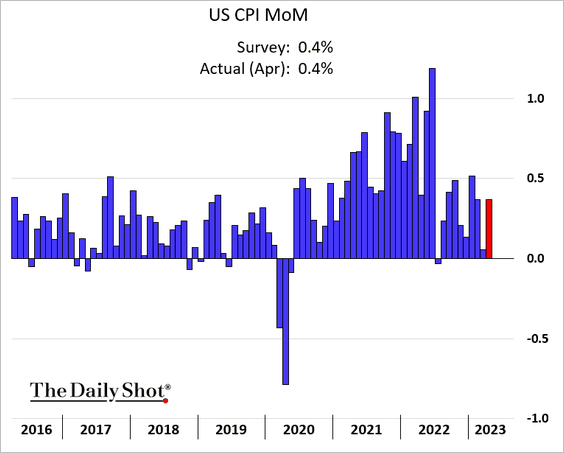
– Core CPI:
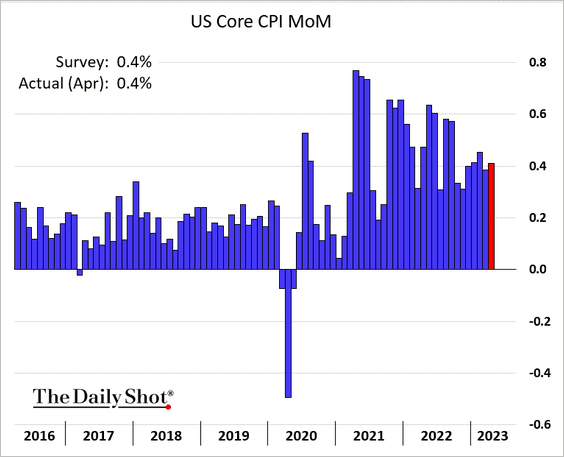
• Core goods inflation jumped, pushed higher by used vehicle prices.
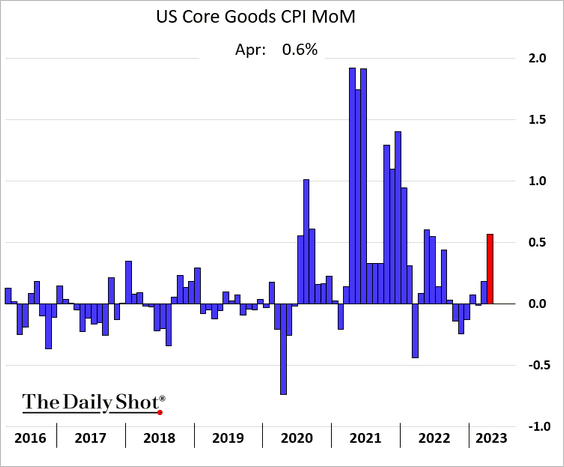
• Core services inflation slowed, which gave markets some comfort.
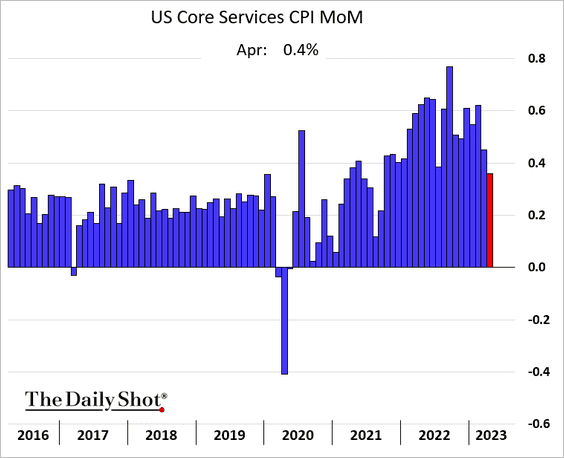
In particular, the markets saw the “supercore” inflation slowdown as a positive sign.
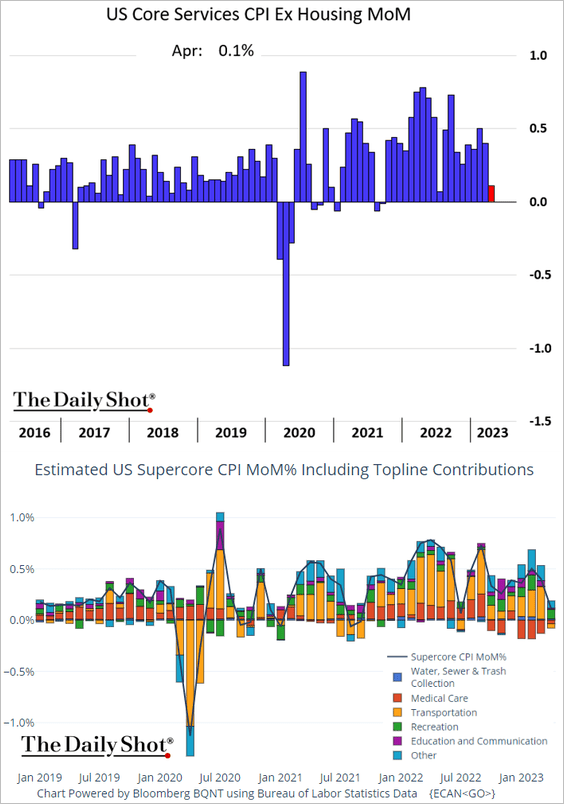 Source: @TheTerminal, Bloomberg Finance L.P.
Source: @TheTerminal, Bloomberg Finance L.P.
 Source: @boes_, @gutavsaraiva, @readep, @economics Read full article
Source: @boes_, @gutavsaraiva, @readep, @economics Read full article
• Let’s take a look at some price trends in the automotive sector.
– Used car prices surged on tight supplies (as we saw in Nomura’s report yesterday).
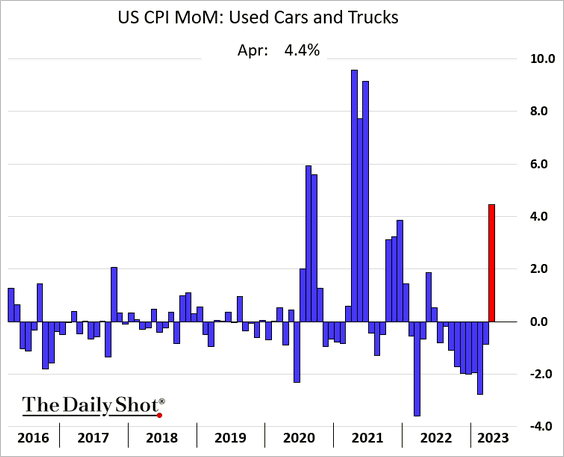
Wholesale prices suggest that these gains will slow or begin reversing.
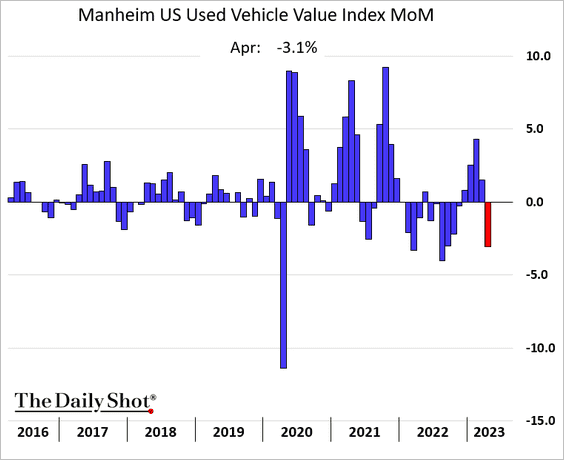
– New car prices declined for the first time in nearly two years, …
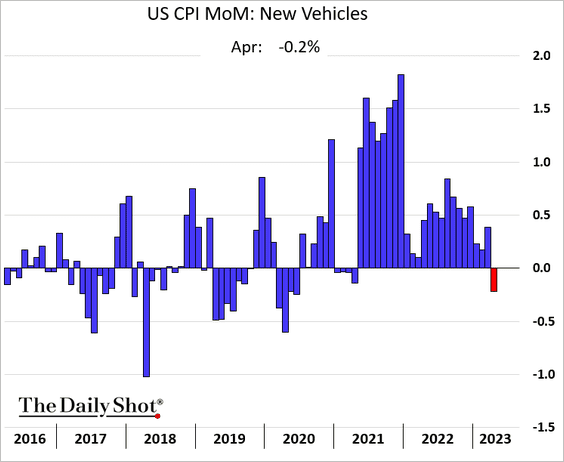
… as dealers offered incentives.
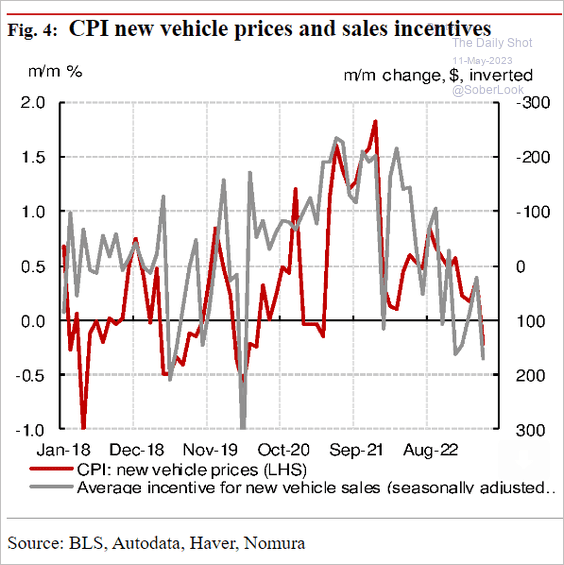 Source: Nomura Securities
Source: Nomura Securities
– Parts prices jumped again in April.
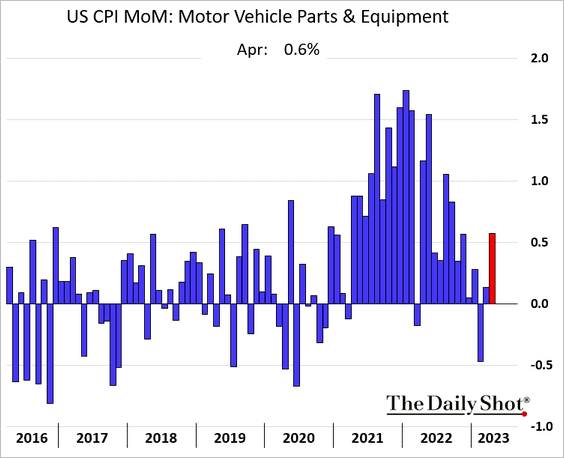
– Auto repair costs continue to surge …
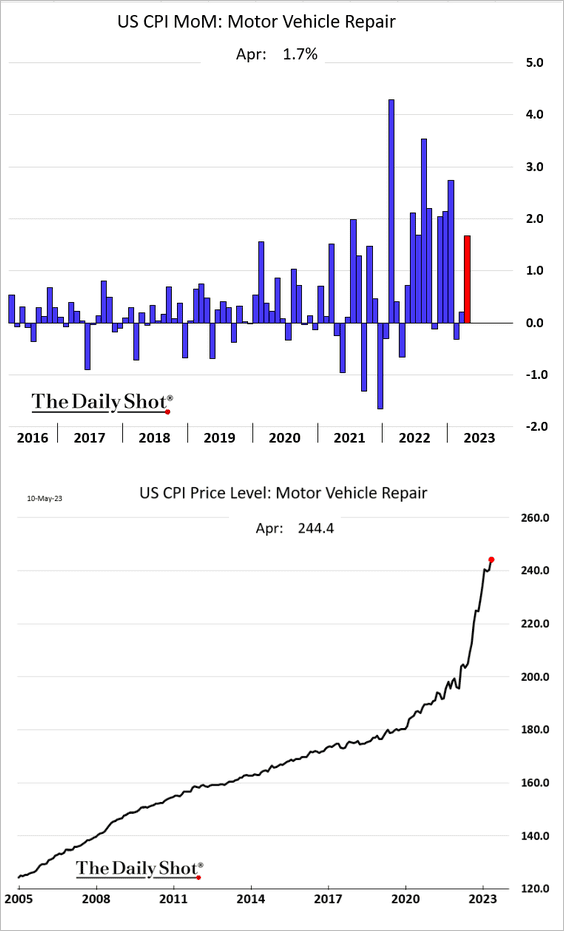
… driving up auto insurance costs.
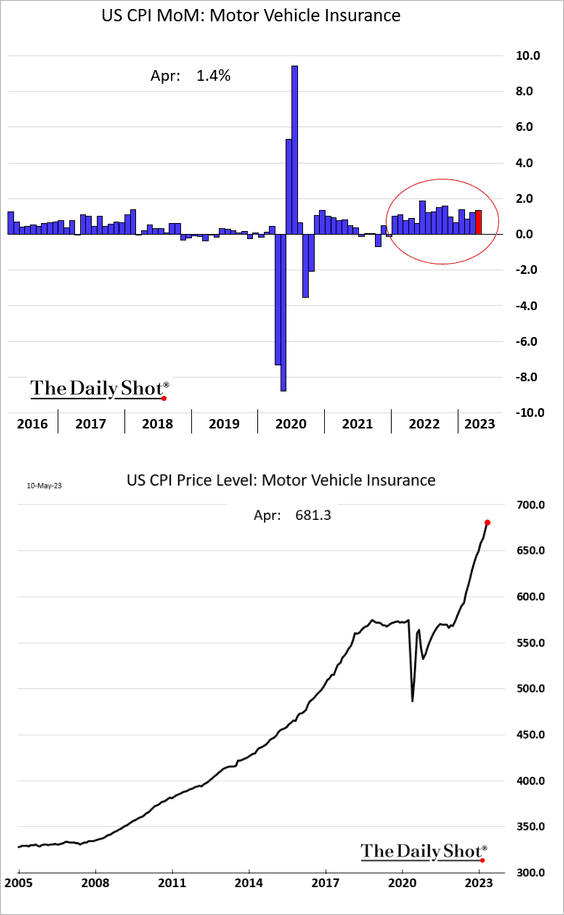
• Here are some additional CPI trends.
– Key contributions:
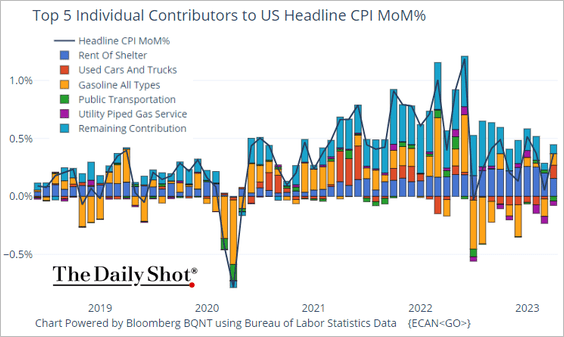 Source: @TheTerminal, Bloomberg Finance L.P.
Source: @TheTerminal, Bloomberg Finance L.P.
– Groceries:
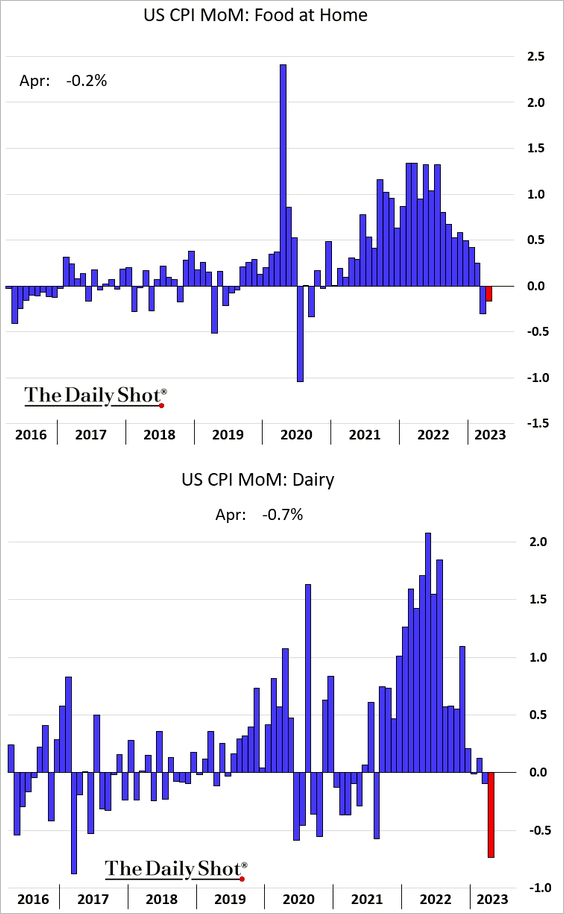
– Baby formula (biggest increase on record):
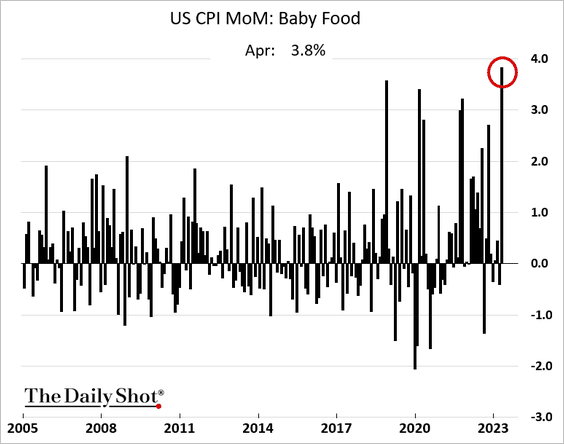
– Rent and owners’ equivalent rent (price gains were up again in April):
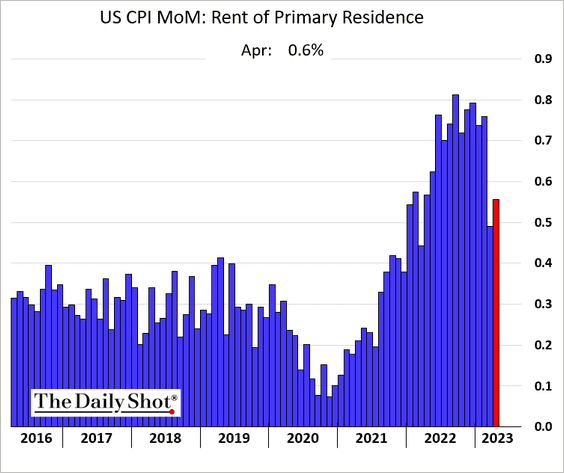
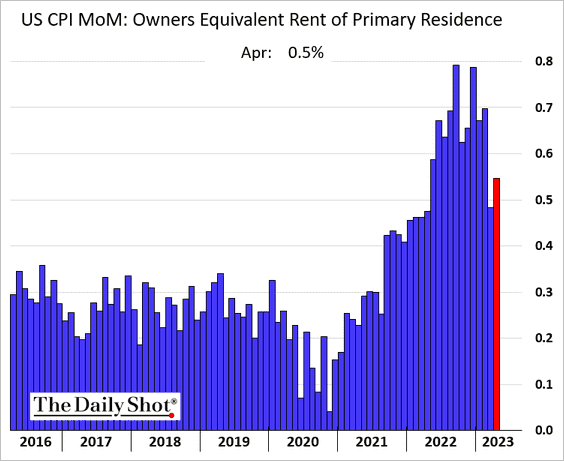
– Furniture (dented by the housing market):
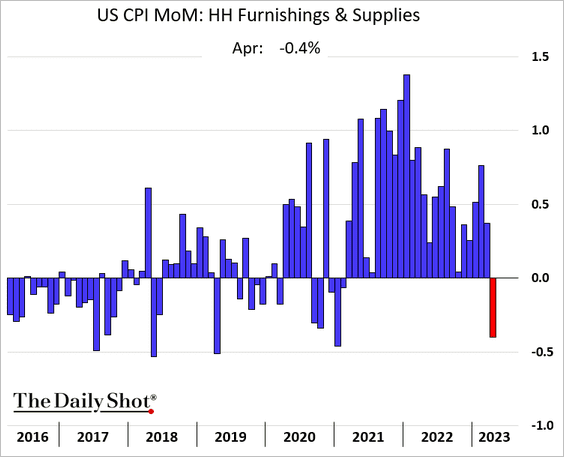
We will have more updates on inflation shortly.
——————–
2. The market saw the CPI report as dovish, pushing yields lower.
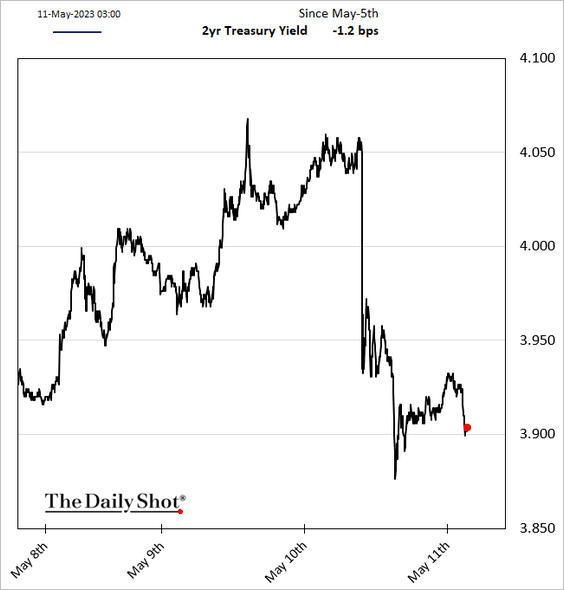
The dollar declined after the CPI report but is up this morning amid a haven bid.
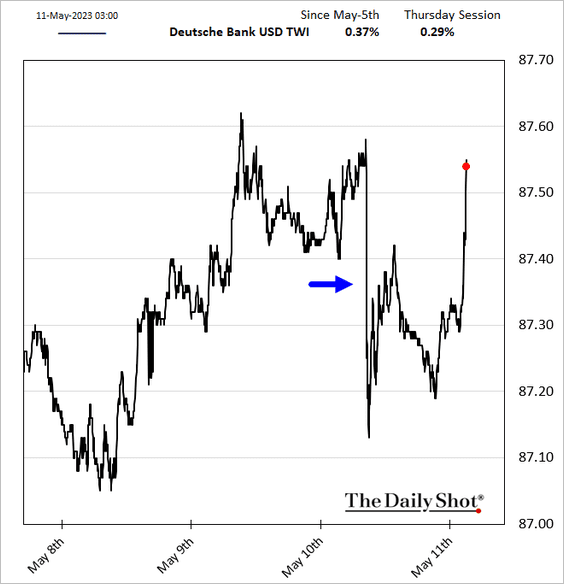
——————–
3. The Earnest Analytics Spend Index doesn’t bode well for retail sales in April, …
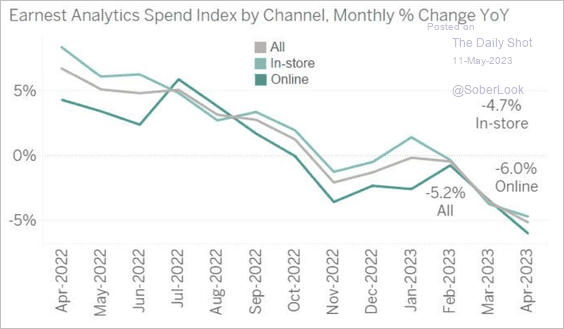 Source: Earnest
Source: Earnest
… as rate/credit conditions tighten sharply for consumers.
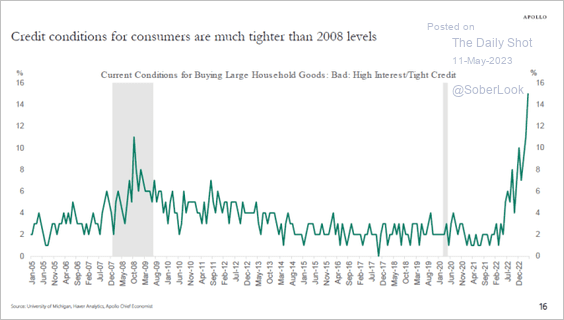 Source: Torsten Slok, Apollo
Source: Torsten Slok, Apollo
However, excess savings remain elevated for now.
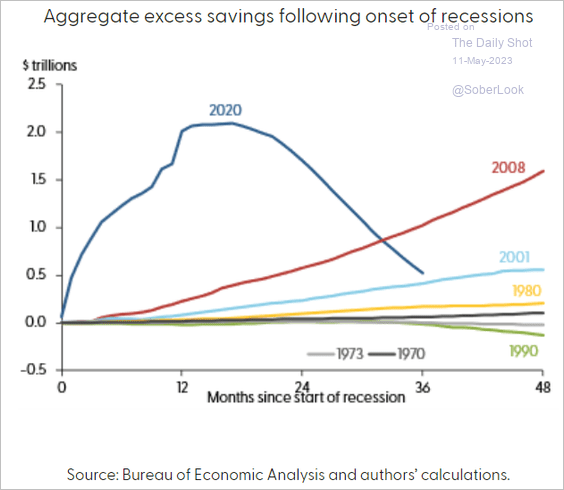 Source: Hamza Abdelrahman and Luiz Oliveira, Federal Reserve Bank of San Francisco
Source: Hamza Abdelrahman and Luiz Oliveira, Federal Reserve Bank of San Francisco
——————–
4. The April federal budget surplus was weaker than expected due to slower tax receipts.
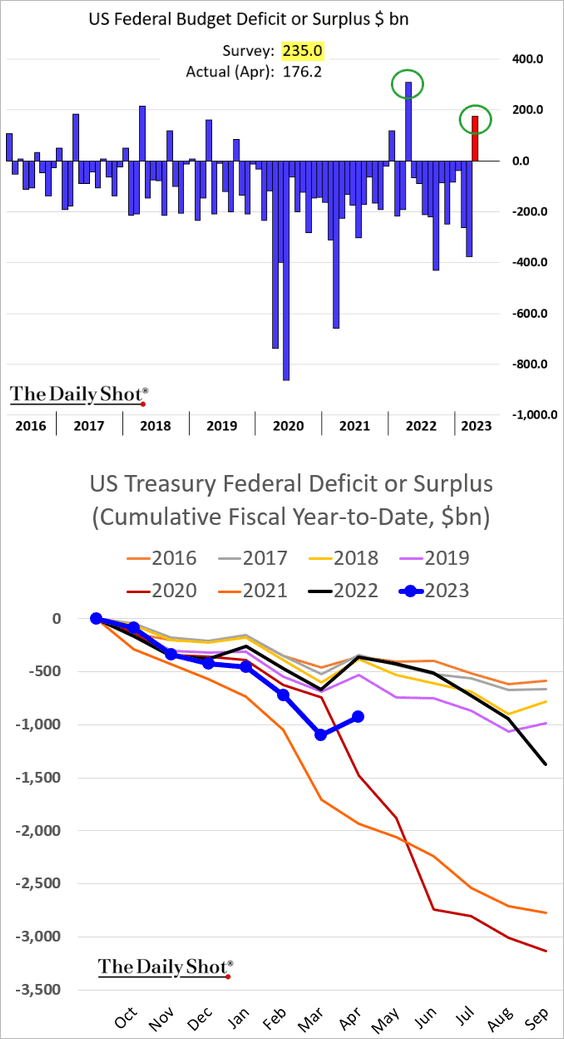
 Source: @v_dendrinou
Source: @v_dendrinou
• The Fed is no longer contributing cash to the US Treasury.
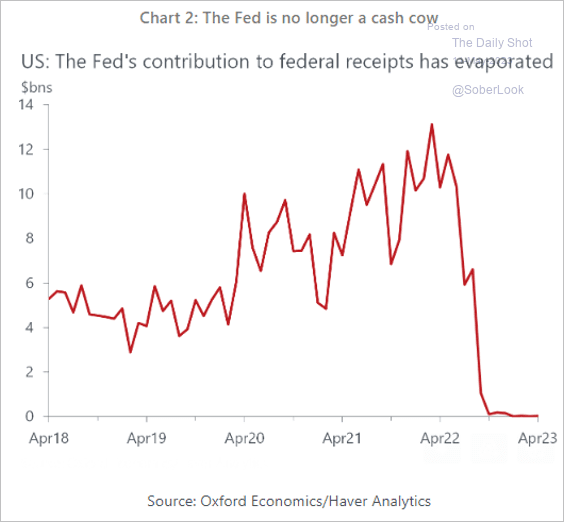 Source: Oxford Economics
Source: Oxford Economics
• The government’s interest expense keeps rising.
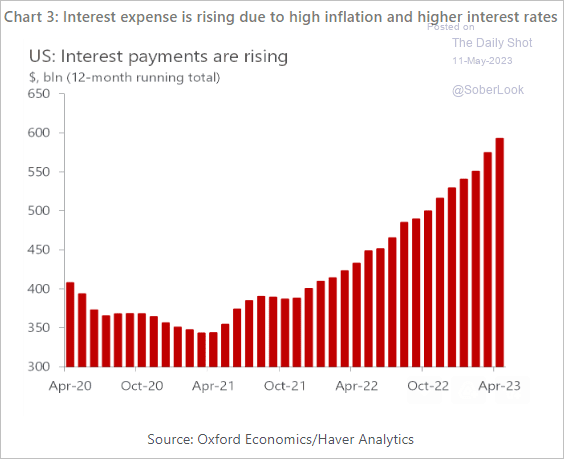 Source: Oxford Economics
Source: Oxford Economics
——————–
5. The market continues to expect substantial rate cuts starting in the second half of this year.
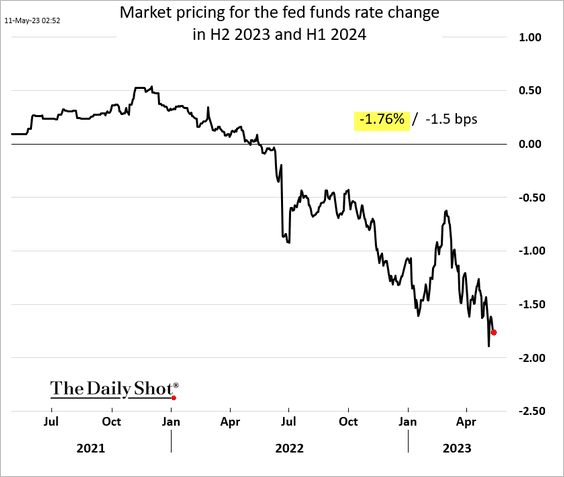
6. The 1-month T-bill yield surged well above the rest of the curve as the X-date looms.
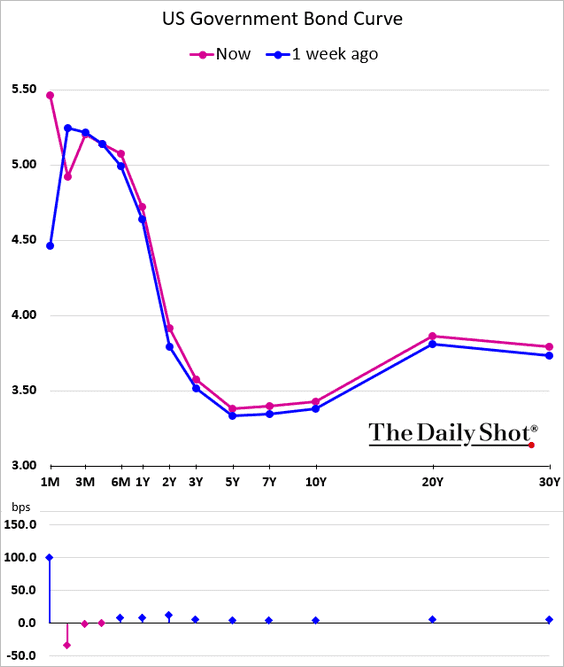
The spread between the 10-year and the 1-month Treasury yields hit a new low.
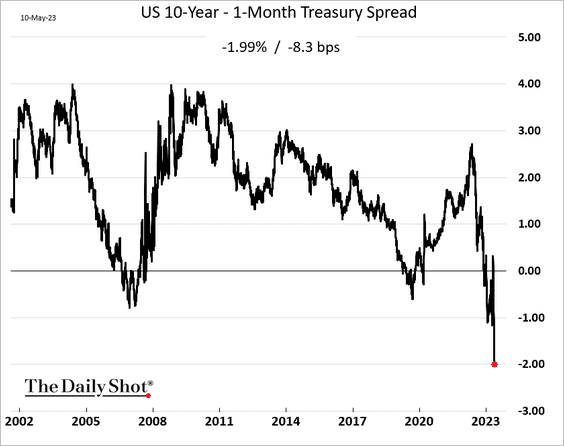
Back to Index
Canada
1. Building permits unexpectedly jumped in March.
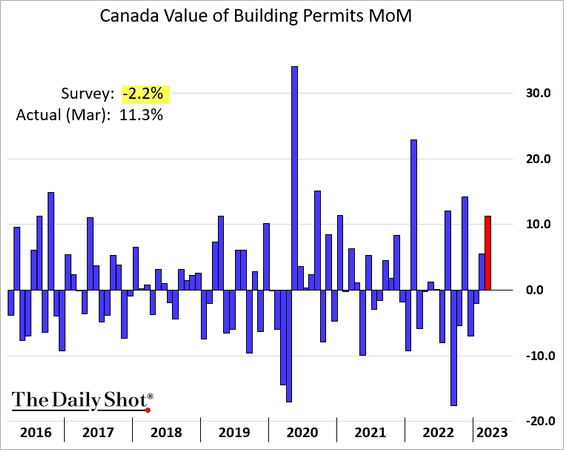
2. Oxford Economics expects house prices to fall another 10% by the end of this year, resulting in a 20%+ drawdown from the February 2022 high.
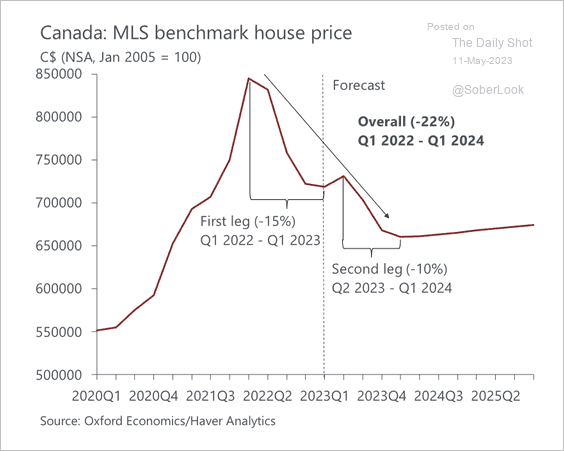 Source: Oxford Economics
Source: Oxford Economics
• House prices will need to fall much further to realign with affordability.
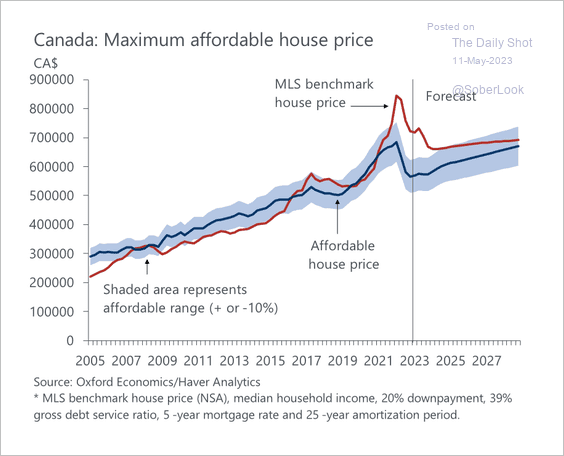 Source: Oxford Economics
Source: Oxford Economics
• Here is a look at house price affordability by region.
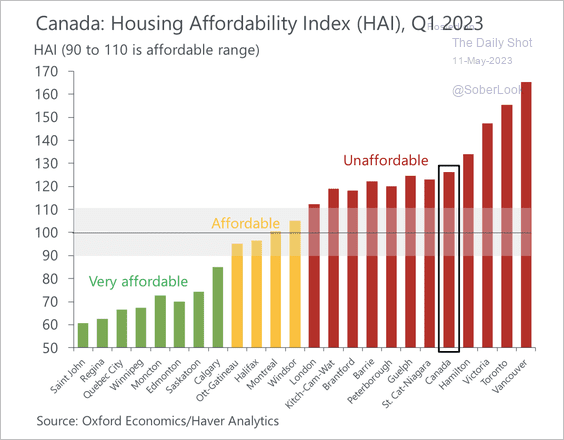 Source: Oxford Economics
Source: Oxford Economics
Back to Index
The United Kingdom
1. The housing market continues to struggle.
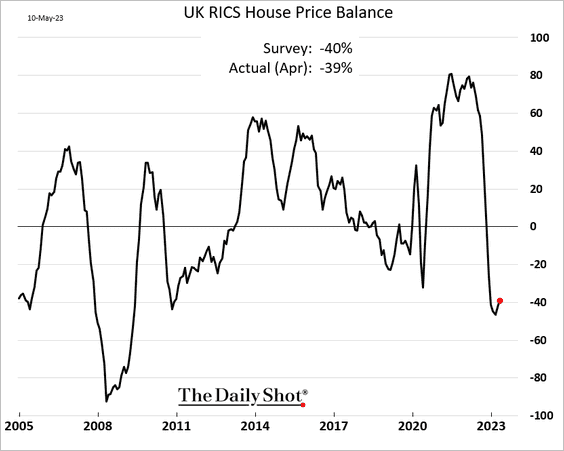
 Source: Reuters Read full article
Source: Reuters Read full article
——————–
2. Services exports are experiencing significant growth.
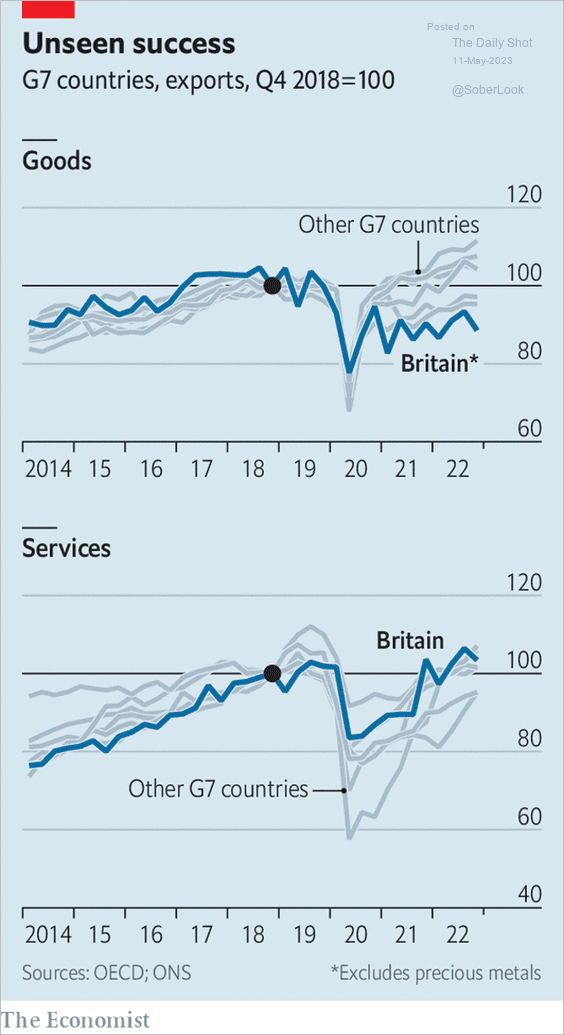 Source: The Economist Read full article
Source: The Economist Read full article
3. Net migration has rebounded.
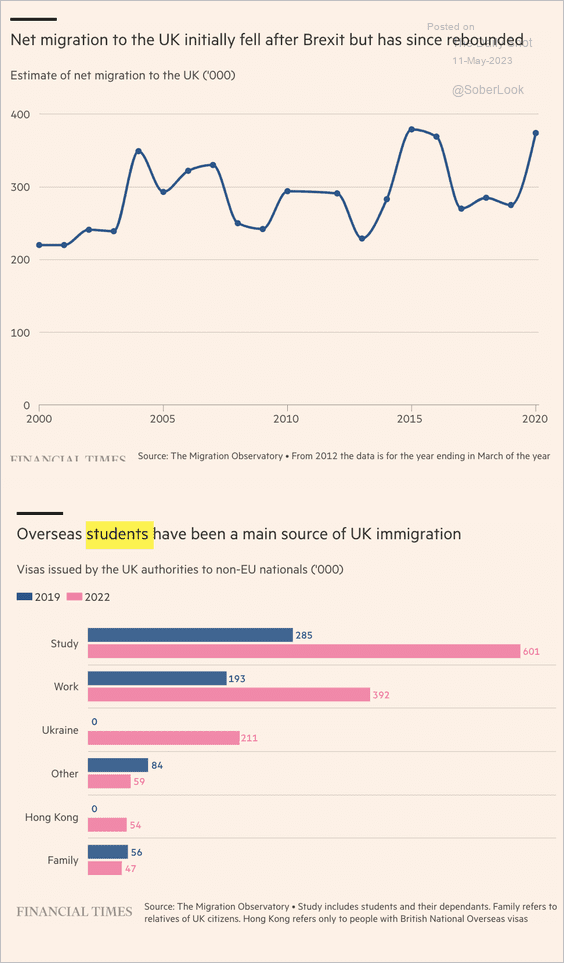 Source: @financialtimes Read full article
Source: @financialtimes Read full article
Back to Index
The Eurozone
1. The market is pricing in two additional rate hikes ahead. Could we see more?
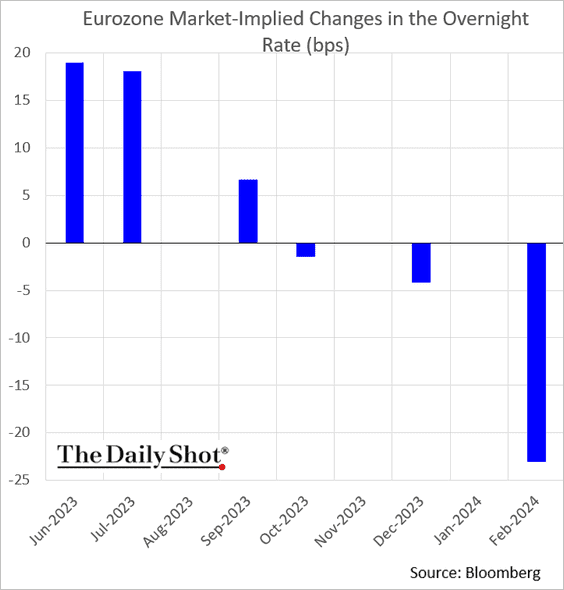
 Source: @Alemrome, @jrandow, @economics Read full article
Source: @Alemrome, @jrandow, @economics Read full article
• Services inflation is yet to peak.
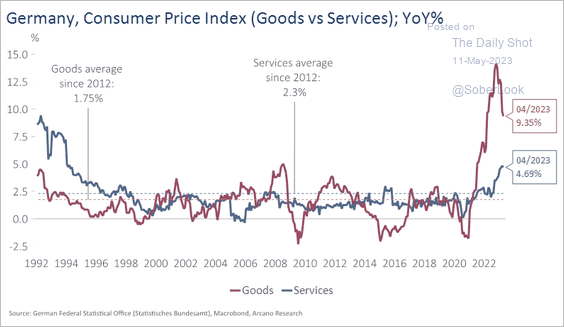 Source: Arcano Economics
Source: Arcano Economics
• The market is pricing a rapid moderation in the CPI.
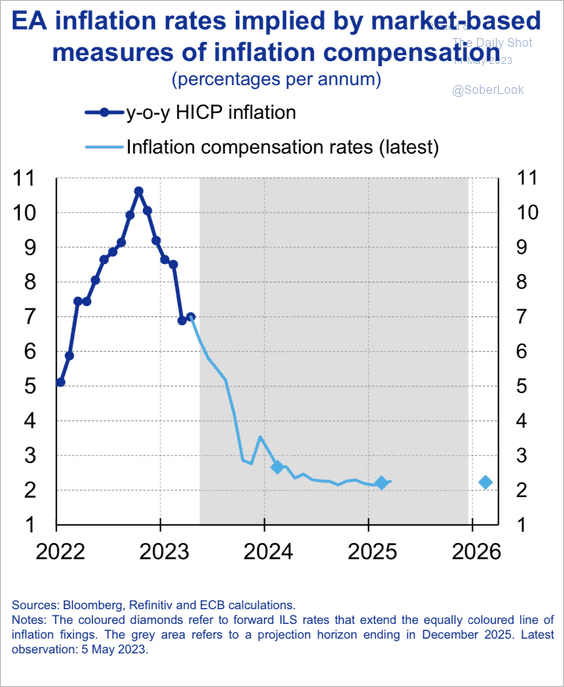 Source: ECB
Source: ECB
——————–
2. The economic surprise differential with the US points to downside risks for the euro.
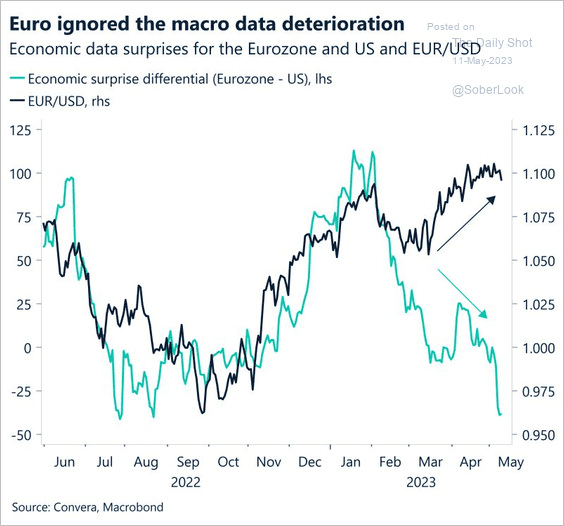 Source: Boris Kovacevic
Source: Boris Kovacevic
3. Italy’s industrial output is slowing.
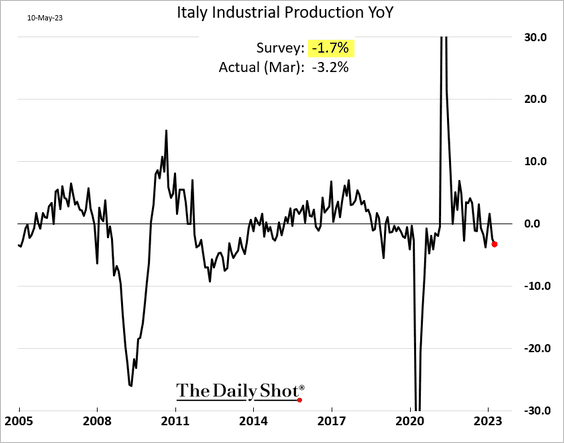
 Source: Reuters Read full article
Source: Reuters Read full article
——————–
4. Dutch factory output softened further in March.
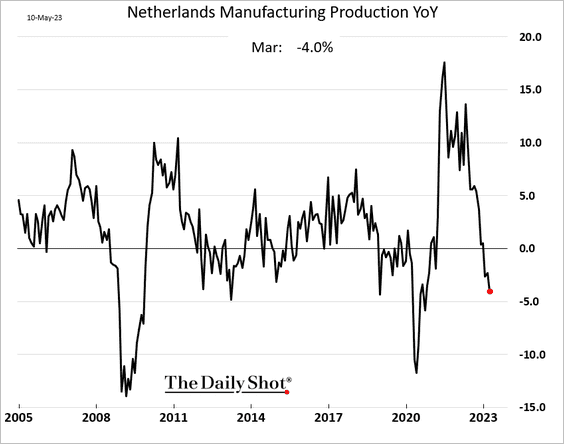
Back to Index
Europe
1. Sweden’s key indicators weakened in March.
• Services output:
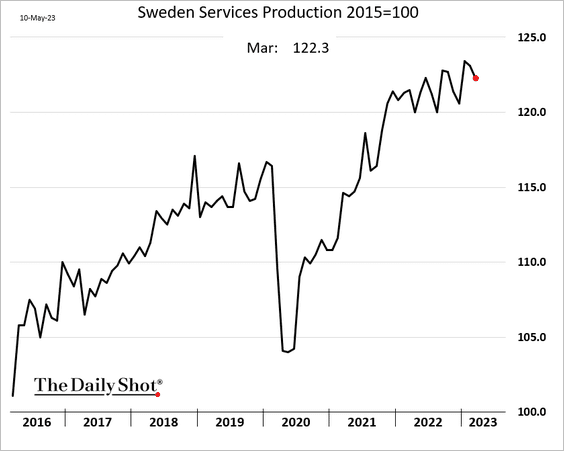
• Industrial production:
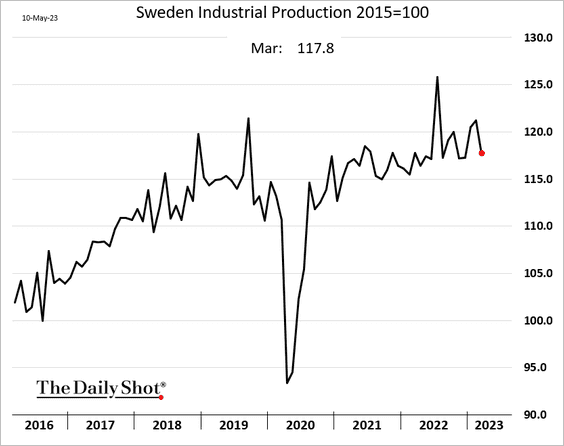
• Household consumption (sharp deterioration):
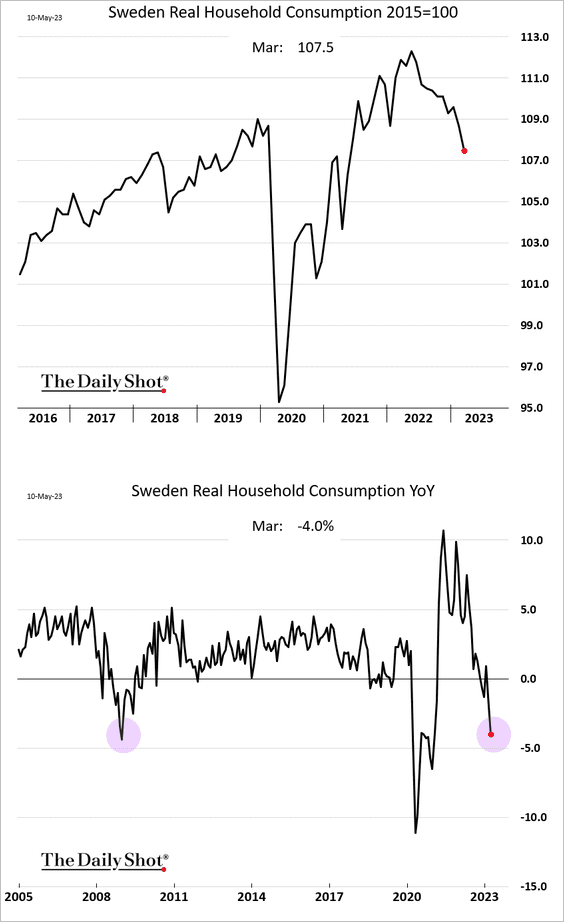
——————–
2. Norway’s inflation continues to run hot.
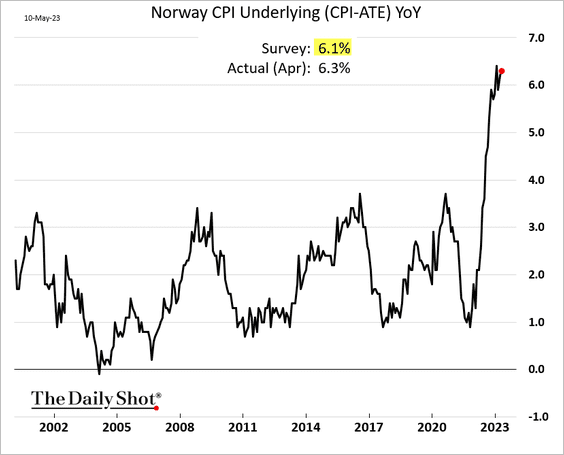
 Source: @ottummelas, @economics Read full article
Source: @ottummelas, @economics Read full article
——————–
3. Czech factory output hit a record high.
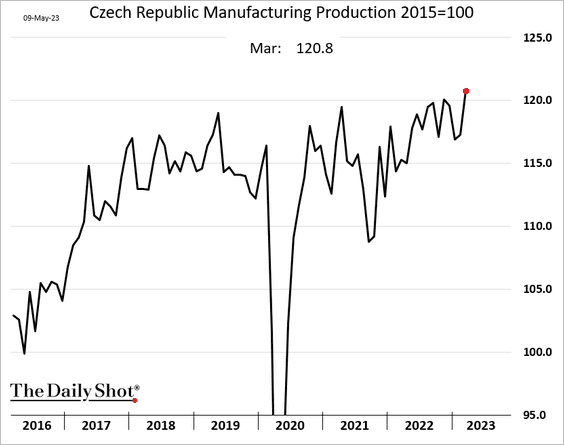
4. The Polish zloty is surging (chart shows EUR declining against PLN).
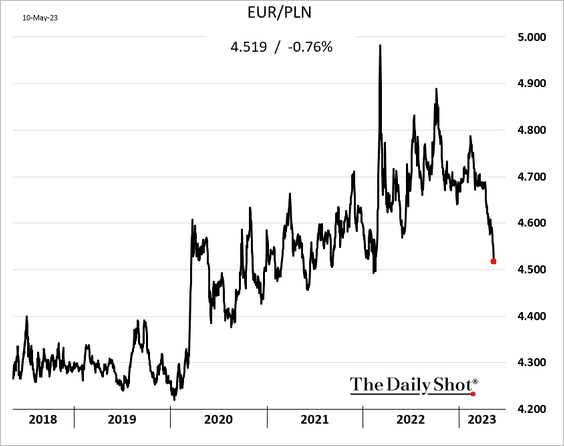
5. Despite the sanctions, the EU is trading with Russia via Kazakhstan.
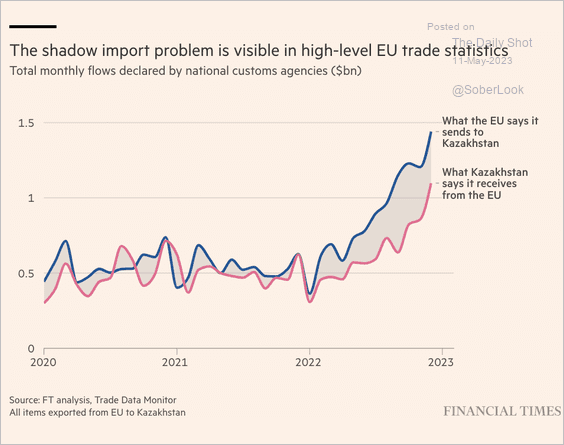 Source: @financialtimes Read full article
Source: @financialtimes Read full article
6. Here is NATO Europe’s defense spending.
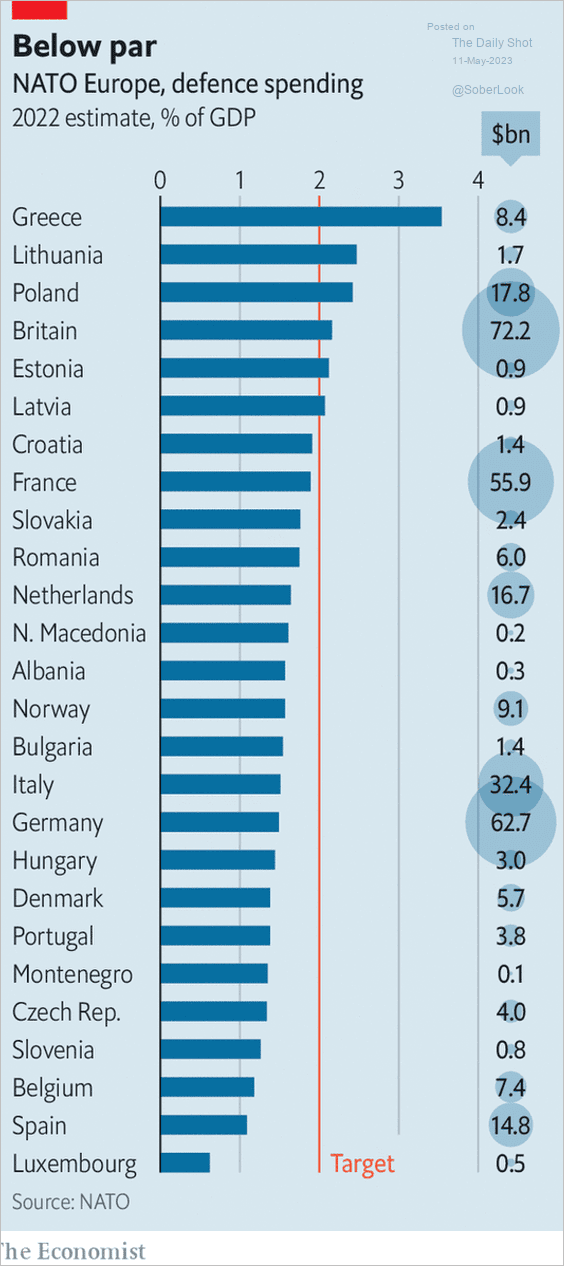 Source: The Economist Read full article
Source: The Economist Read full article
Back to Index
Asia-Pacific
1. Japan’s current account surplus was smaller than expected in March.
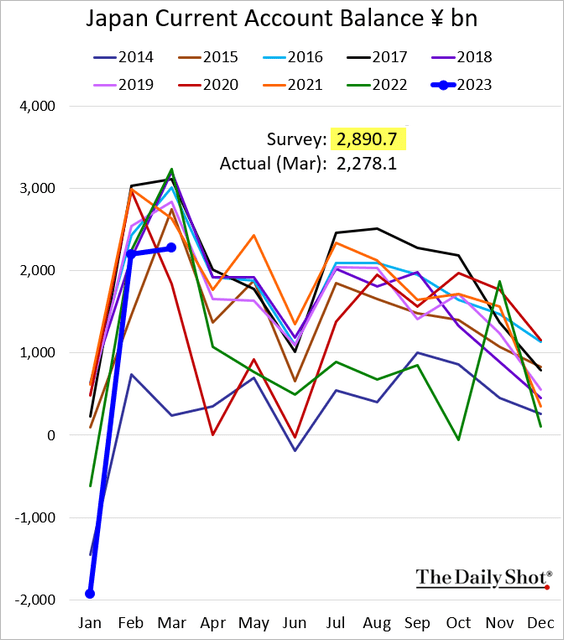
The trade deficit continues to narrow.
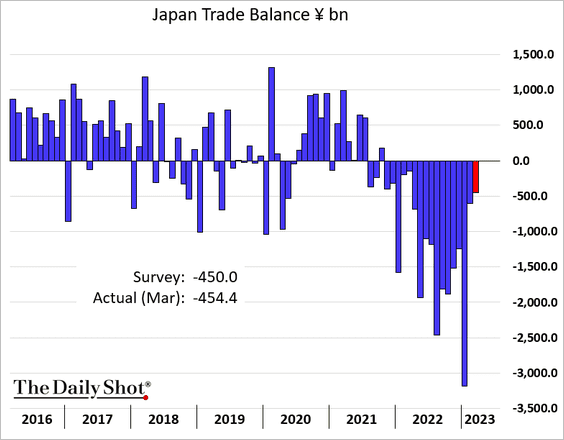
——————–
2. Next, we have some updates on South Korea.
• Economists continue to downgrade their GDP forecasts for this year.
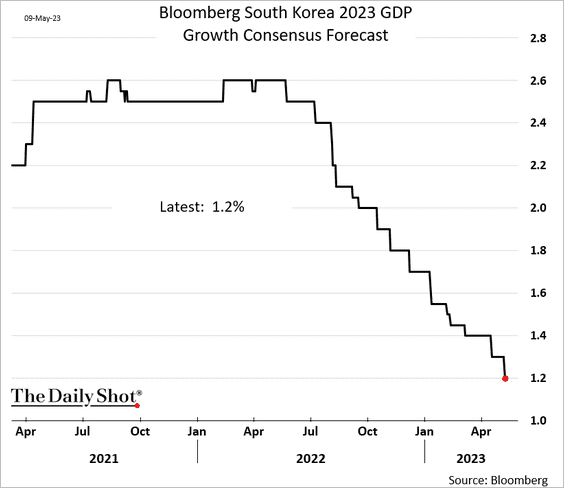
• The current account balance is back in surplus.
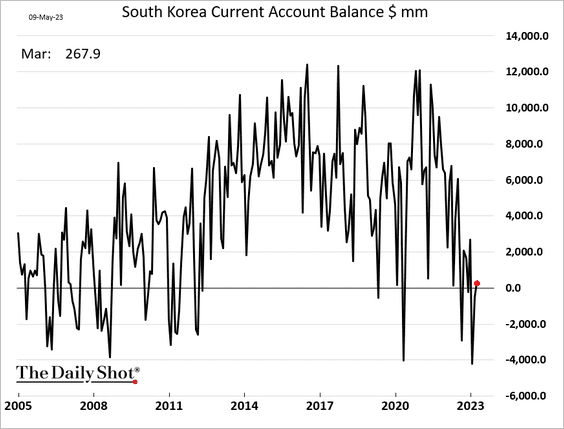
• The unemployment rate is near multi-decade lows.
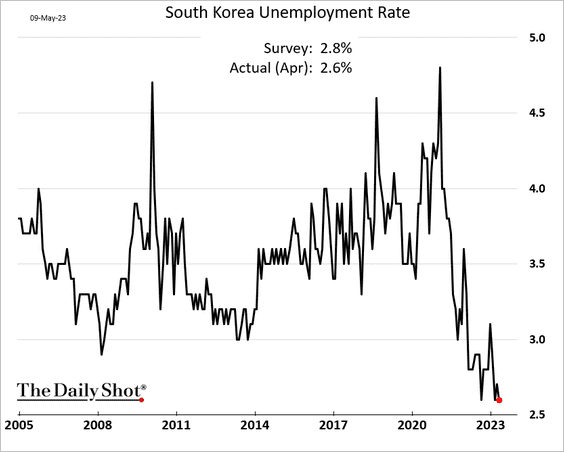
——————–
3. New Zealand’s home sales remain depressed.
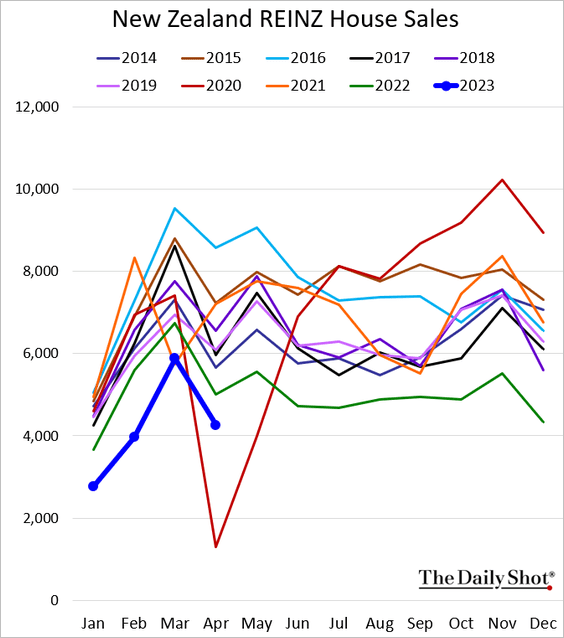
Back to Index
China
1. The CPI surprised to the downside, …
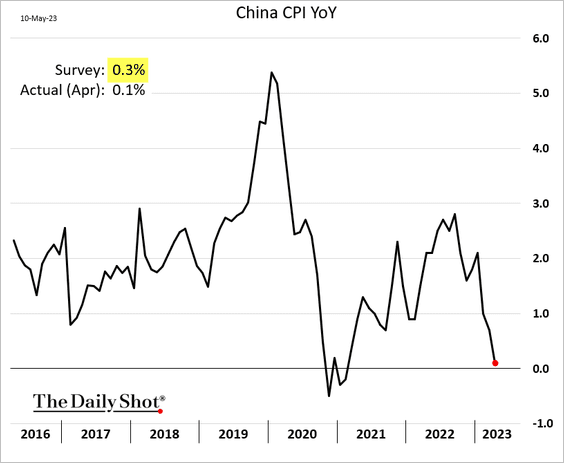
… with softer readings driven by food prices.
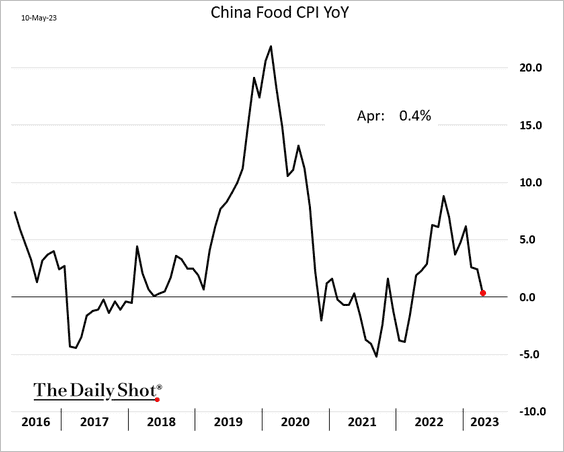
• However, services inflation climbed amid increased consumer demand.
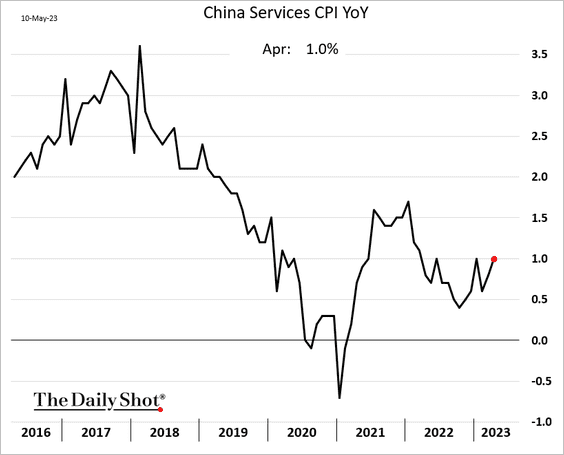
• The core CPI held steady.
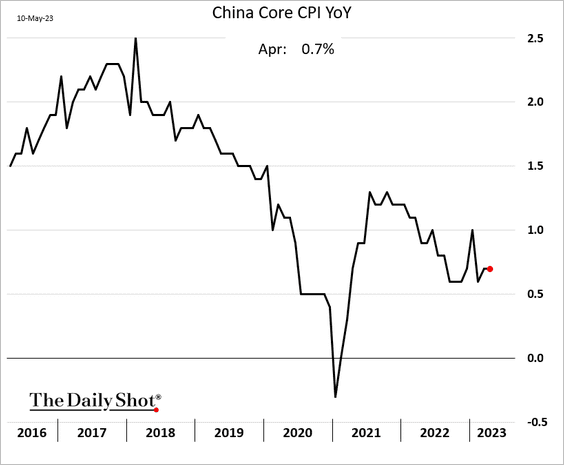
• Rising wages could boost inflation.
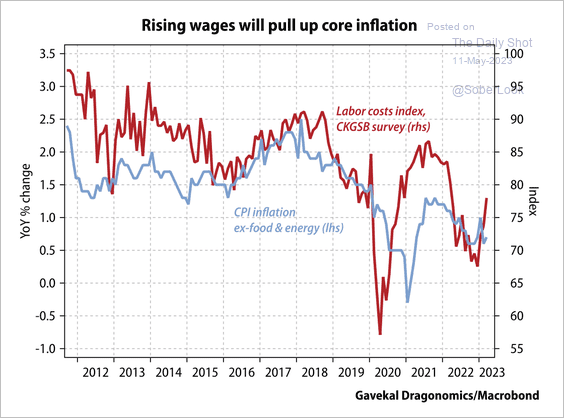 Source: Gavekal Research
Source: Gavekal Research
——————–
2. The PPI moved deeper into negative territory.
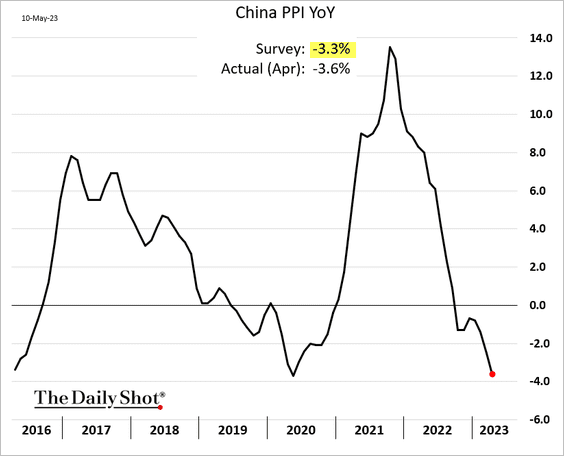
Here are some examples.
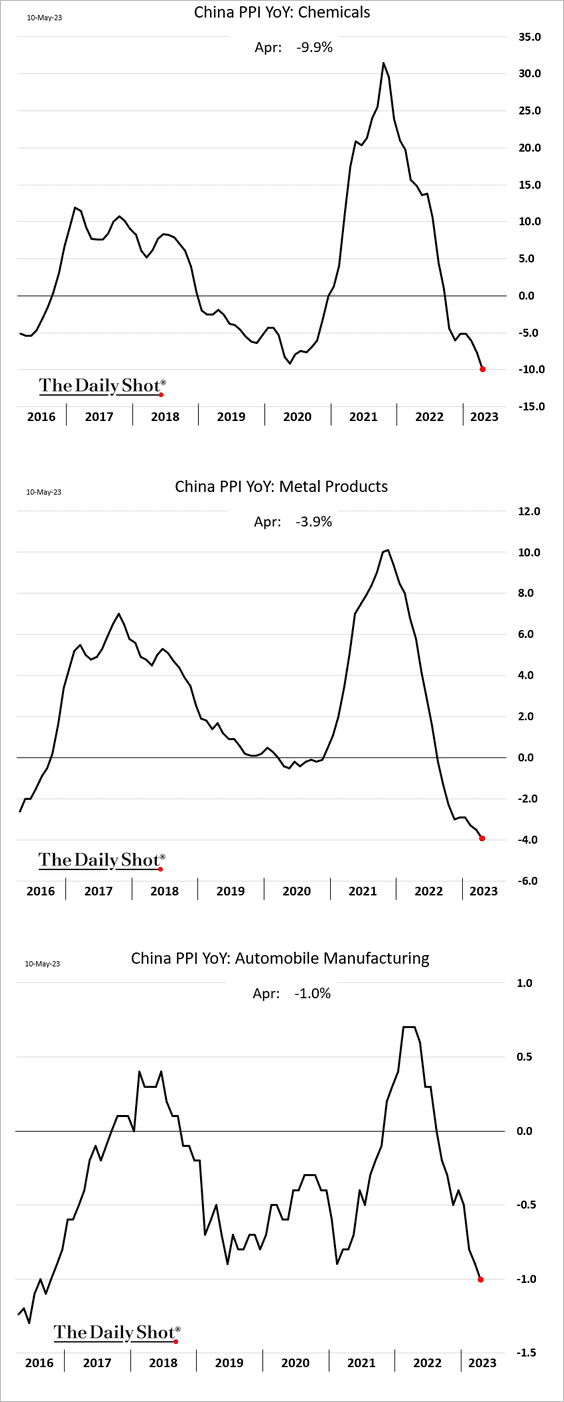
——————–
3. Domestic equity trading volumes and margin financing have picked up.
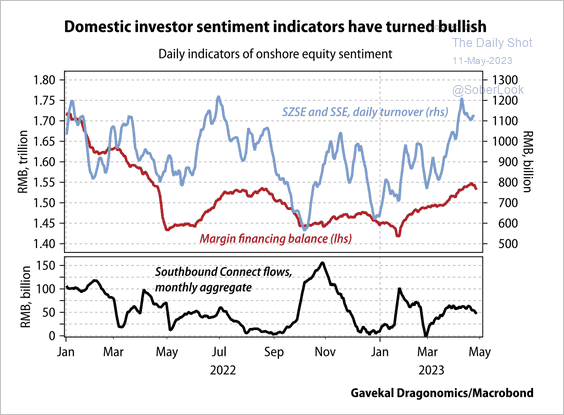 Source: Gavekal Research
Source: Gavekal Research
• State-owned companies have been outperforming.
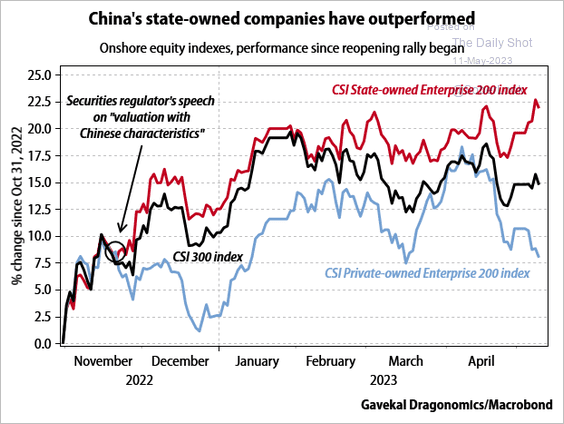 Source: Gavekal Research
Source: Gavekal Research
• The SSE Composite remains in a long-term uptrend, albeit volatile. A sustained break above resistance near 3,500 could attract additional buyers.
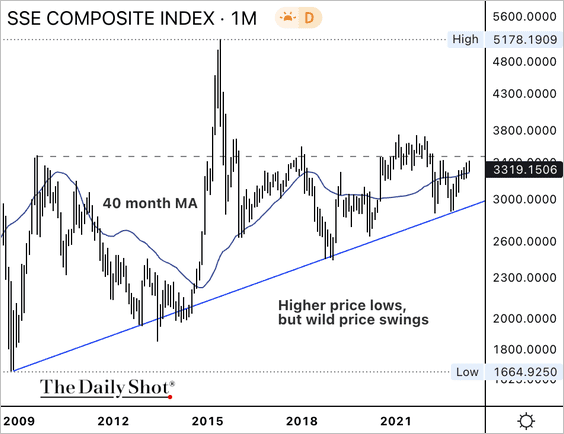
• Similarly, Hong Kong’s Hang Seng Index remains in a volatile uptrend.
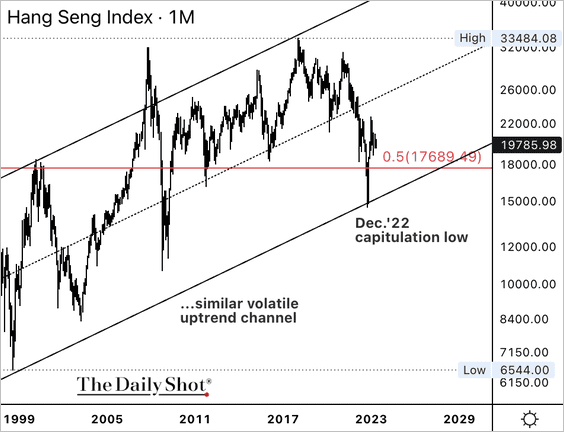
——————–
4. The return on assets on local government financing vehicles (LGFVs) is very low.
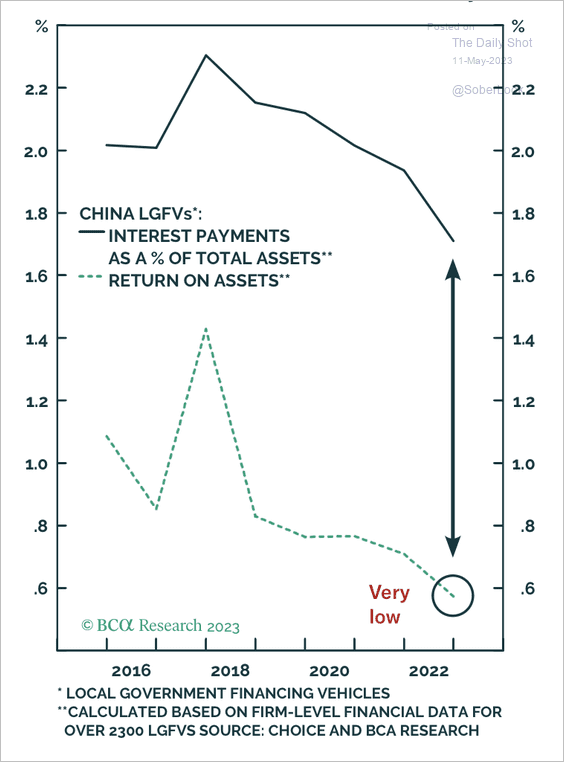 Source: BCA Research
Source: BCA Research
5. China is now a leading auto exporter.
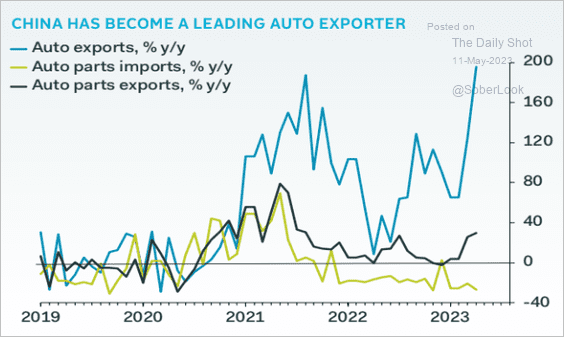 Source: Pantheon Macroeconomics
Source: Pantheon Macroeconomics
6. Next, we have the breakdowns of China’s power capacity and consumption.
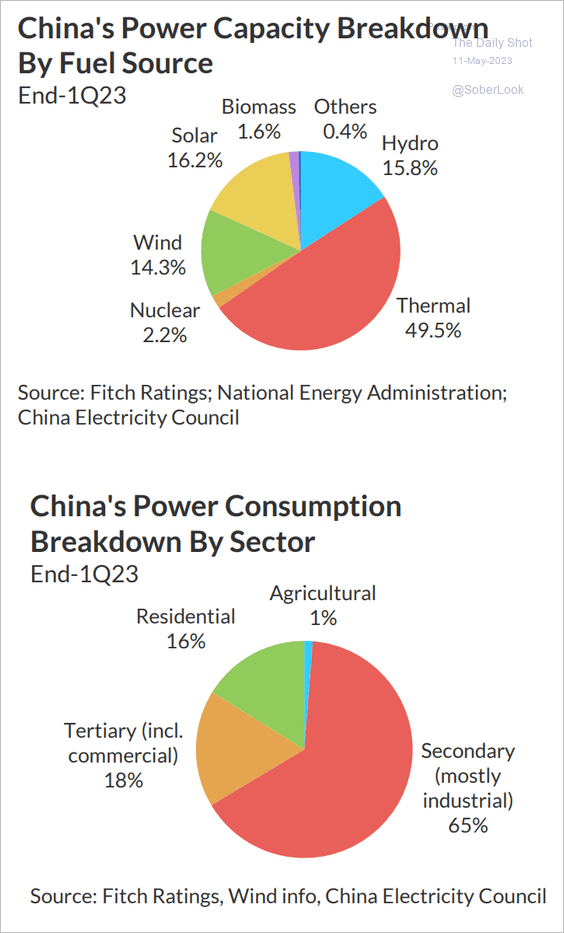 Source: Fitch Ratings
Source: Fitch Ratings
Back to Index
Emerging Markets
1. Brazil’s industrial production improved in March.
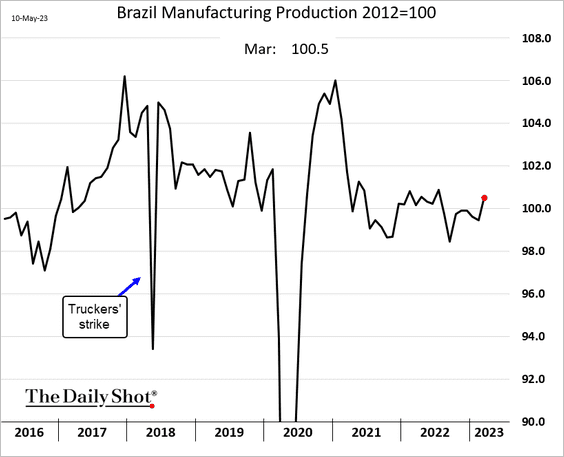
 Source: The Brazilian Report Read full article
Source: The Brazilian Report Read full article
——————–
2. Turkey’s industrial production topped expectations.
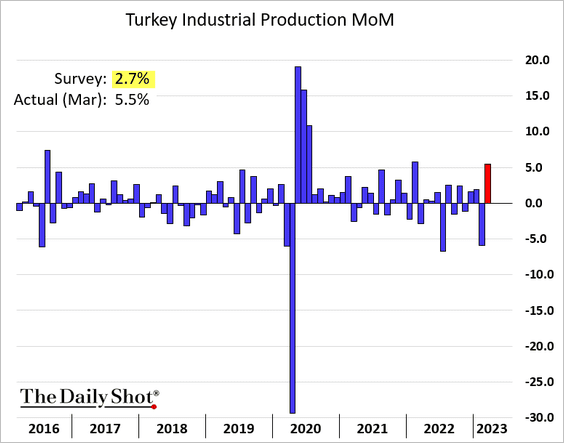
Separately, according to many observers, Turkey is no longer considered a democracy.
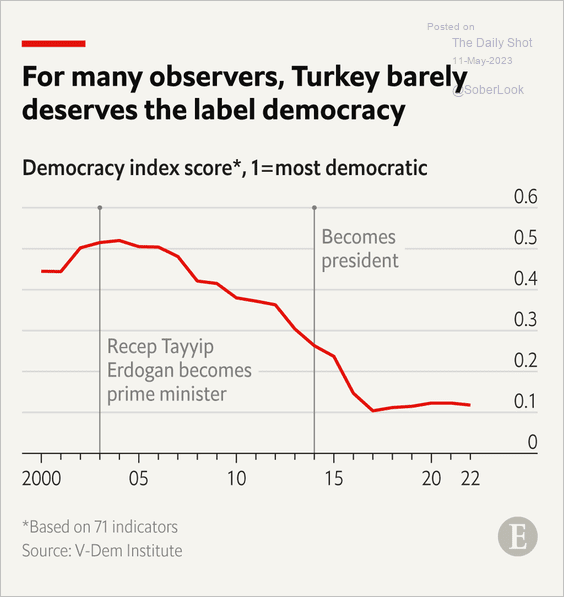 Source: @TheEconomist Read full article
Source: @TheEconomist Read full article
——————–
3. Ukraine’s CPI finally dipped below 20%.
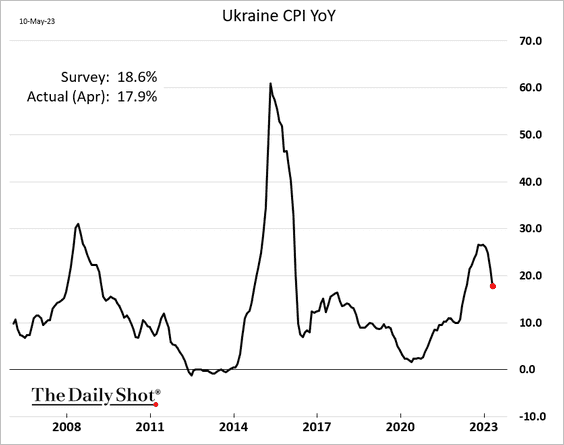
Back to Index
Commodities
1. Industrial metals remain under pressure as concerns about China’s demand persist.
• Iron ore:
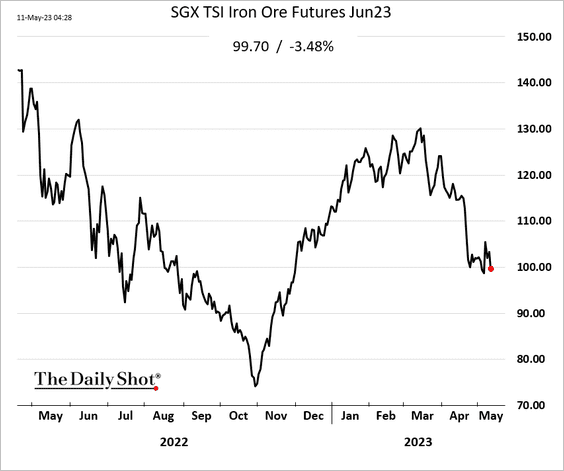
• Copper:
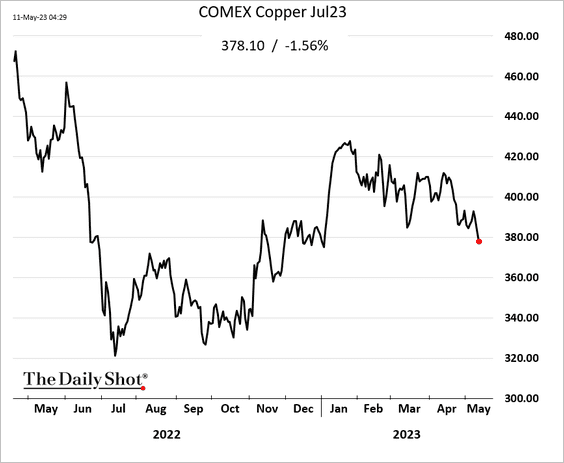
2. Softs have been performing well.
• Cocoa futures are surging in New York amid sluggish exports from Côte d’Ivoire.
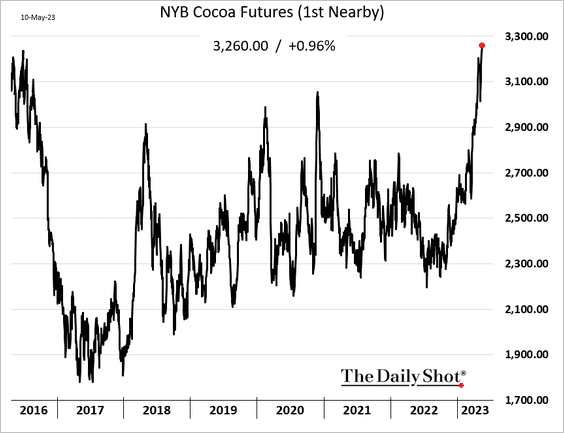
• Sugar keeps climbing amid supply concerns.
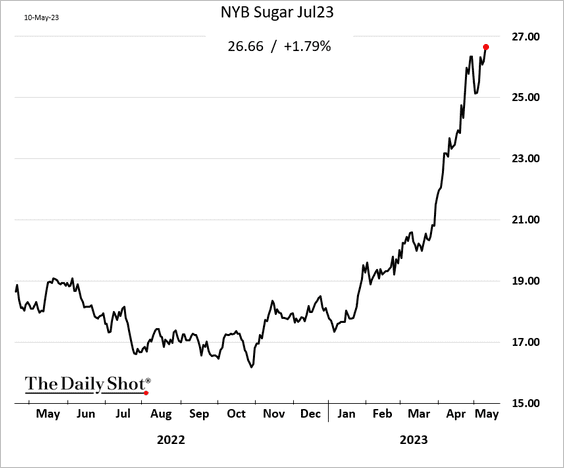
Back to Index
Energy
1. US oil inventories unexpectedly increased last week.
• Weekly changes:
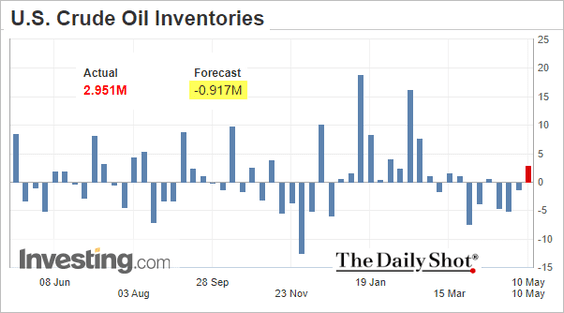
• Level:
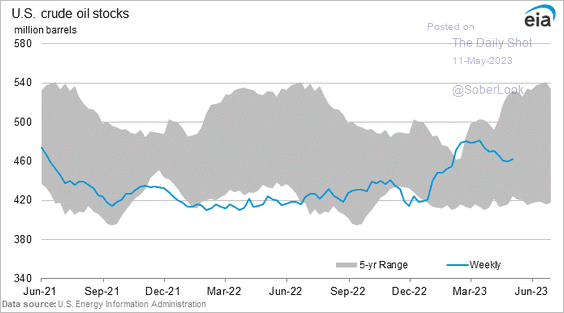
 Source: MarketWatch Read full article
Source: MarketWatch Read full article
However, refined products inventories declined more than expected.
• Gasoline:
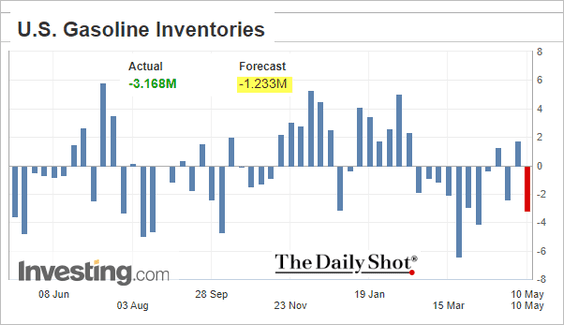
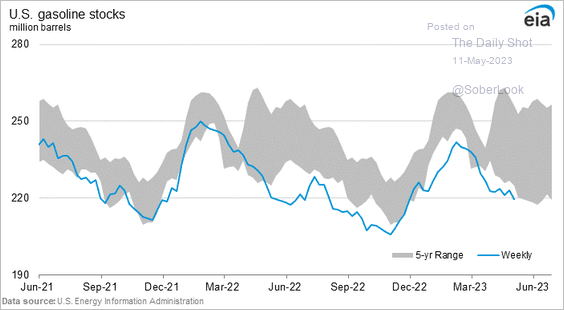
• Distillates:
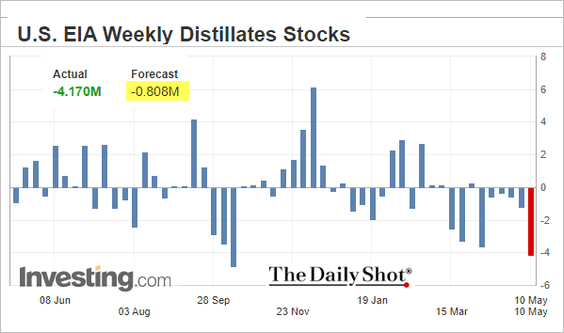
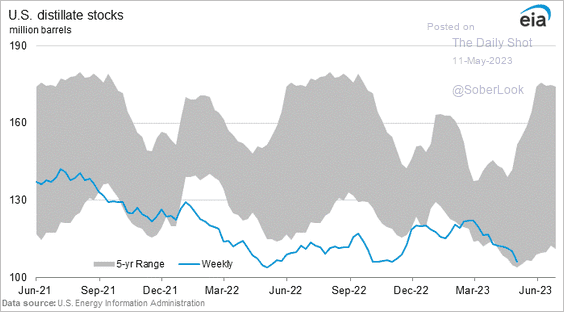
Gasoline demand bounced.
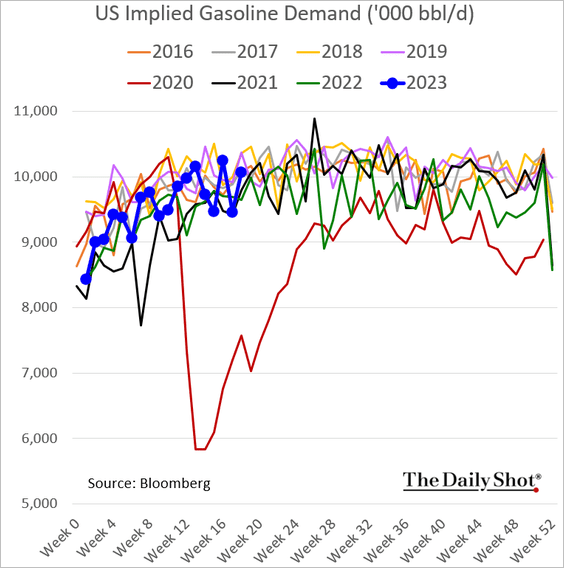
——————–
2. The largest US energy firms continue to limit CapEx despite strong cash flow. Investors want to get paid now.
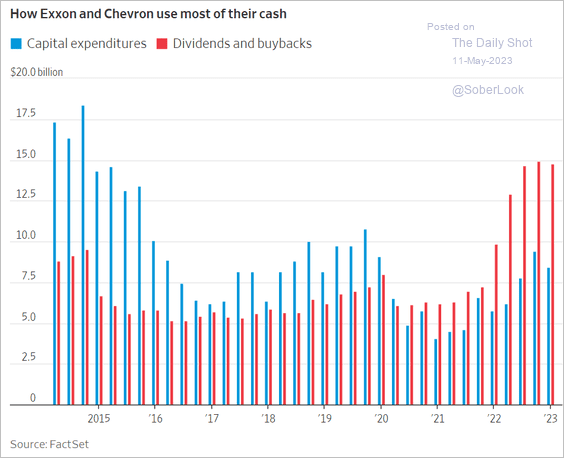 Source: @WSJ Read full article
Source: @WSJ Read full article
3. Here is a look at total oil production by OPEC and OPEC+.
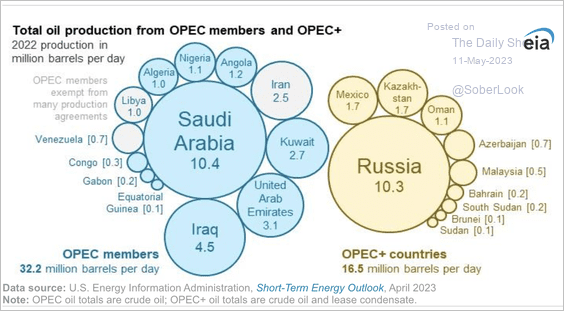 Source: @EIAgov
Source: @EIAgov
4. A majority of Americans surveyed approve of using nuclear energy.
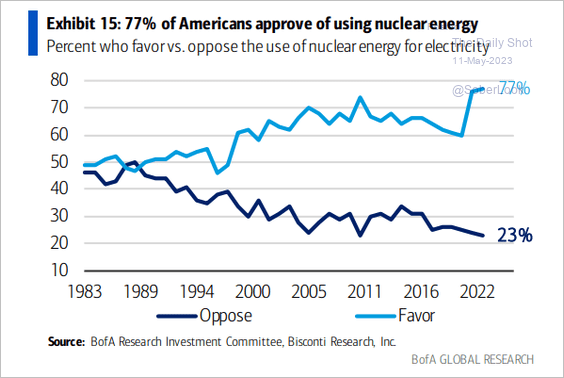 Source: BofA Global Research
Source: BofA Global Research
Back to Index
Equities
1. Long-duration equities have outperformed sharply in recent days.
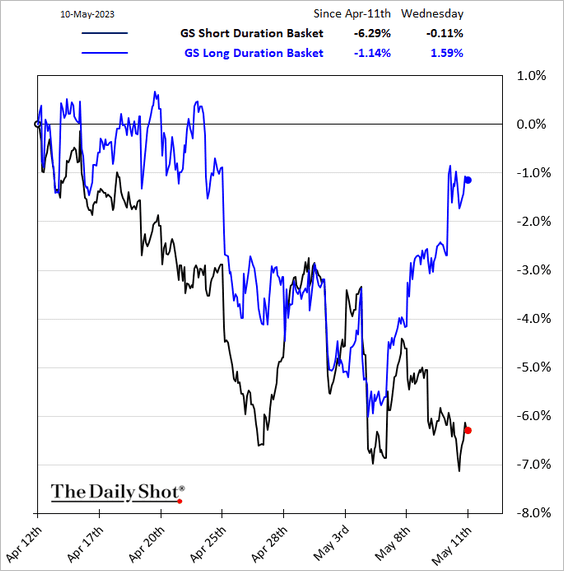
2. Tighter credit conditions will continue to weigh on earnings.
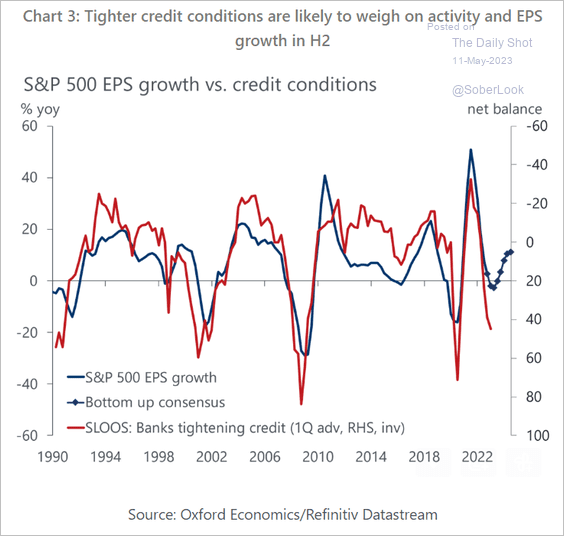 Source: Oxford Economics
Source: Oxford Economics
3. US ETF trading volume has slowed.
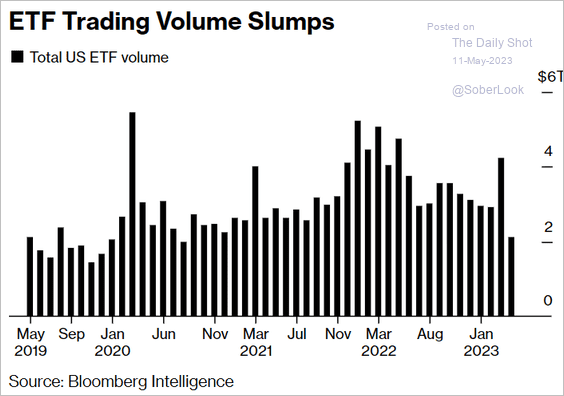 Source: @kgreifeld, @markets Read full article
Source: @kgreifeld, @markets Read full article
4. Next, we have some sector updates.
• Fund flows:
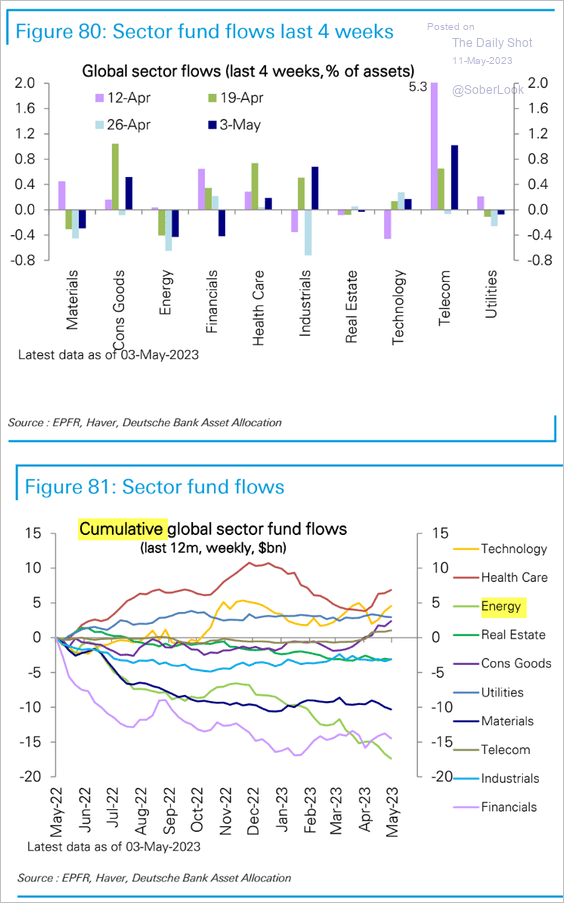 Source: Deutsche Bank Research
Source: Deutsche Bank Research
• Geographic exposure:
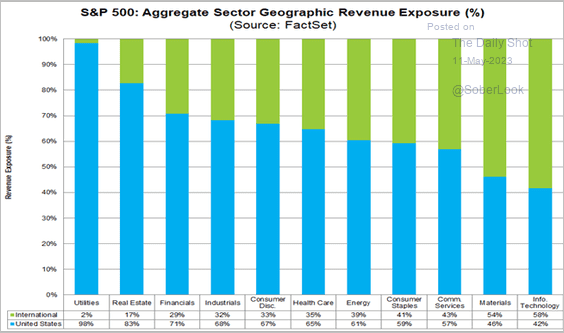 Source: @FactSet Read full article
Source: @FactSet Read full article
– Sector beats vs. foreign exposure:
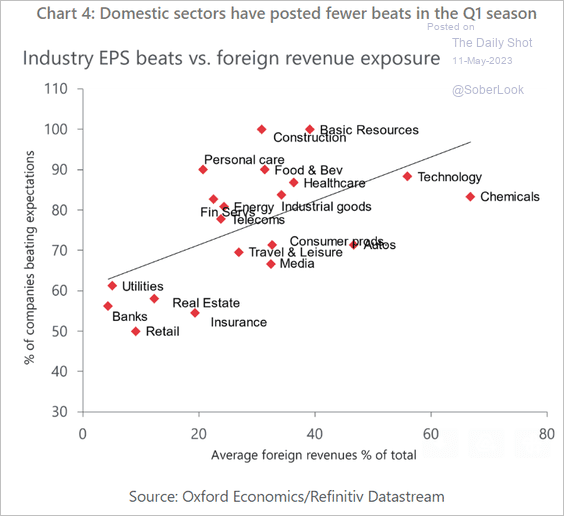 Source: Oxford Economics
Source: Oxford Economics
• Investment managers’ sector outlook:
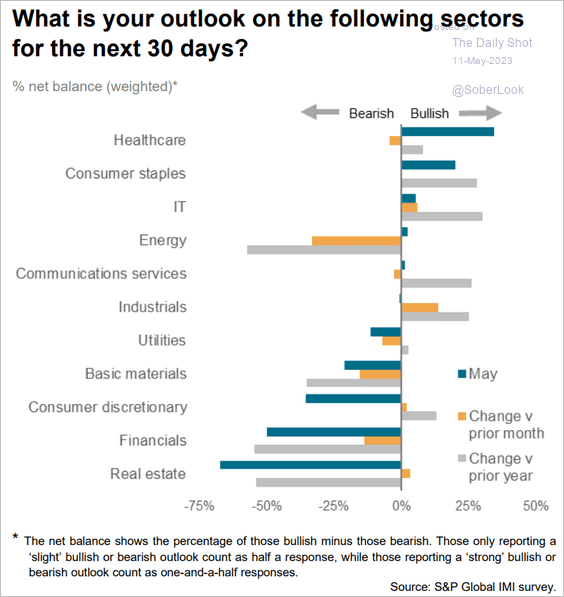 Source: S&P Global PMI
Source: S&P Global PMI
• Airline shares have sold off in recent days.
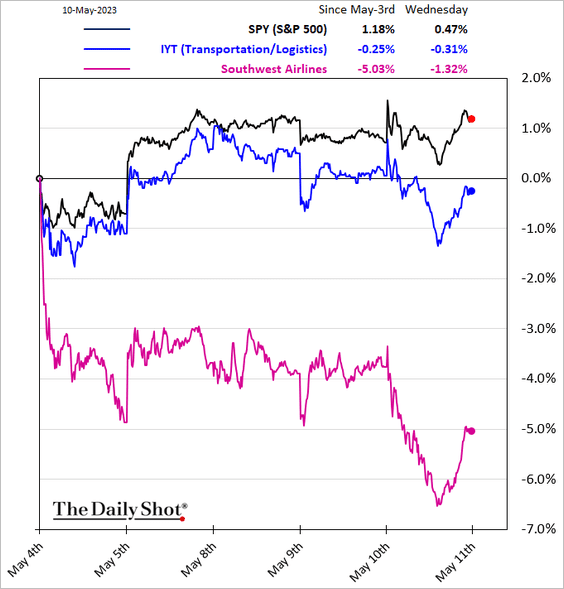
 Source: Reuters Read full article
Source: Reuters Read full article
Back to Index
Credit
1. The share of banks increasing spreads on business loans hit the highest levels since the GFC.
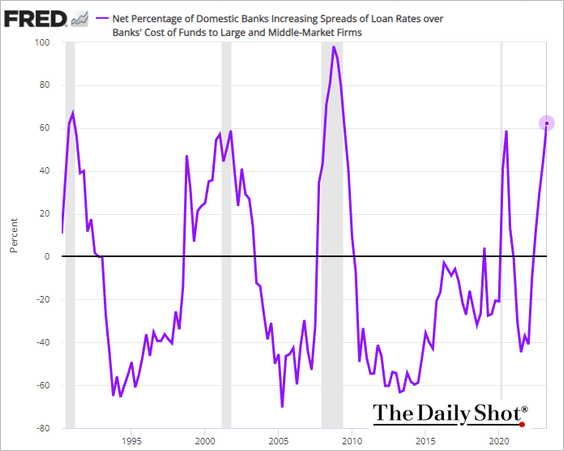
2. Here are the reasons banks have been tightening credit standards.
 Source: Oxford Economics
Source: Oxford Economics
3. Bankruptcies are expected to surge.
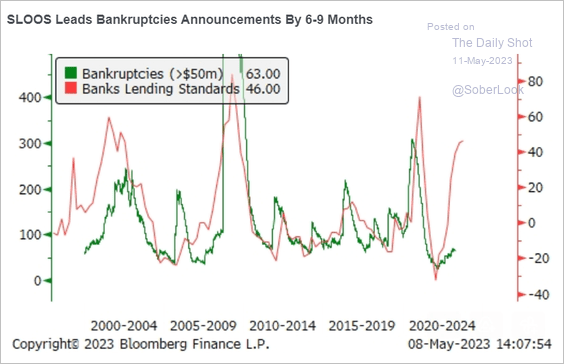 Source: Piper Sandler
Source: Piper Sandler
Repeat bankruptcy filings haven’t been this high since 2009.
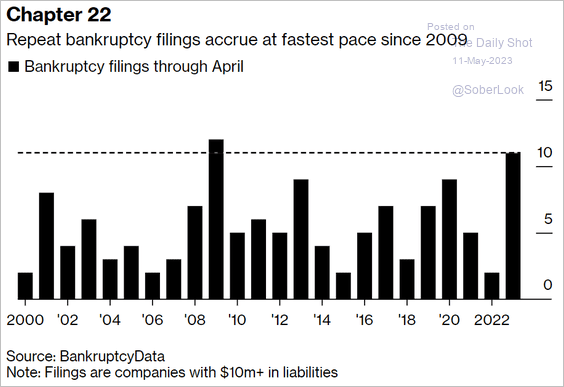 Source: @JeremyHtweets, @sparkyrandles, @markets Read full article
Source: @JeremyHtweets, @sparkyrandles, @markets Read full article
——————–
4. Dealers have cut back their CMBS holdings.
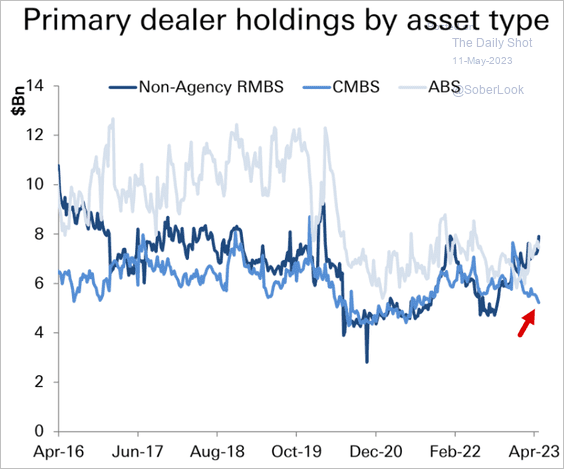 Source: Deutsche Bank Research
Source: Deutsche Bank Research
CMBS issuance has been depressed this year.
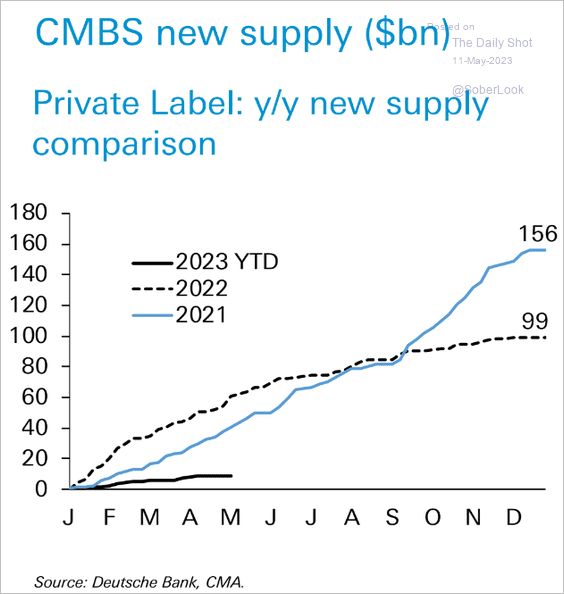 Source: Deutsche Bank Research
Source: Deutsche Bank Research
——————–
5. Middle-market CLOs use private credit estimates because public ratings are not available for smaller firms. Here is the distribution of estimates over time.
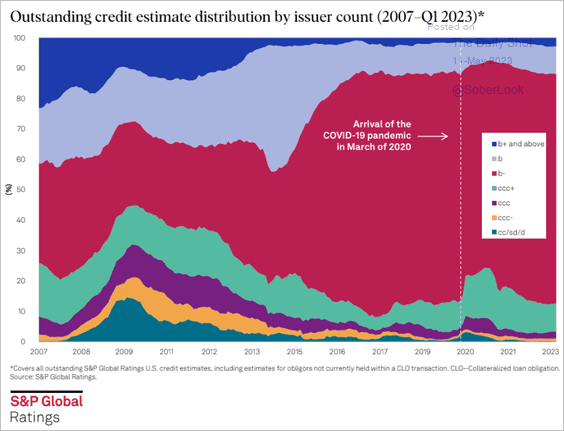 Source: S&P Global Ratings
Source: S&P Global Ratings
• More estimates have been lowered than raised over the past two quarters.
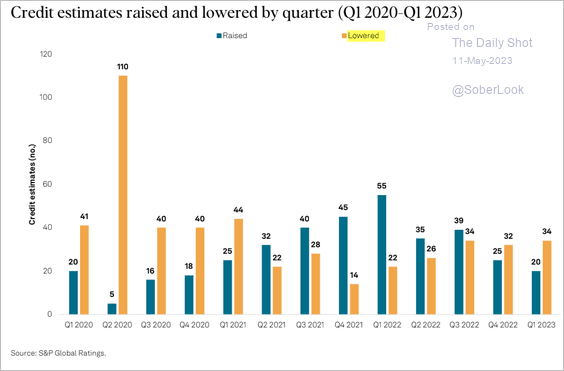 Source: S&P Global Ratings
Source: S&P Global Ratings
• Companies with private estimates pay much higher spreads than those with public ratings.
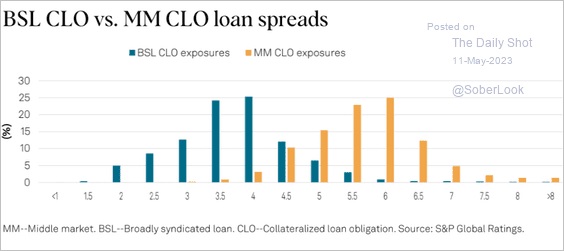 Source: S&P Global Ratings
Source: S&P Global Ratings
Back to Index
Global Developments
1. The UK, Australia, and Canada can maintain larger relative current account deficits than the US without their currencies dominating international reserves.
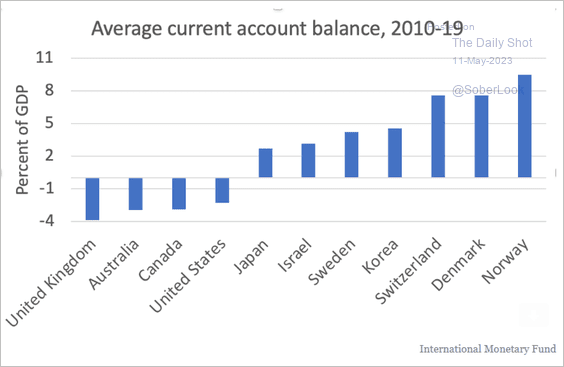 Source: @paulkrugman, The New York Times Read full article
Source: @paulkrugman, The New York Times Read full article
2. OECD leading economic indicators troughed around the S&P 500’s October low.
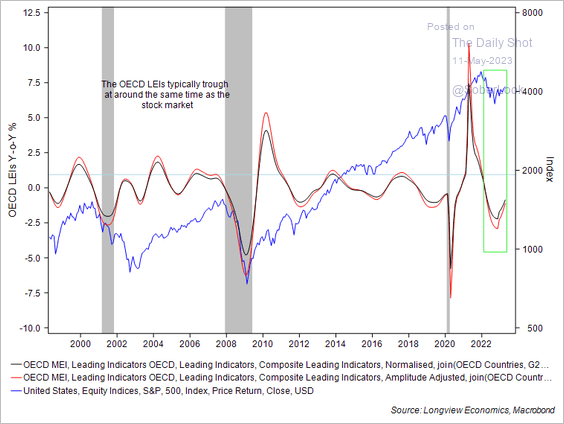 Source: Longview Economics
Source: Longview Economics
3. Global services activity continues to diverge from manufacturing.
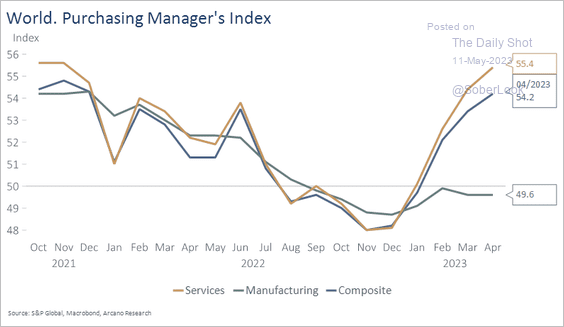 Source: Arcano Economics
Source: Arcano Economics
4. Here is a look at real interest rates around the world.
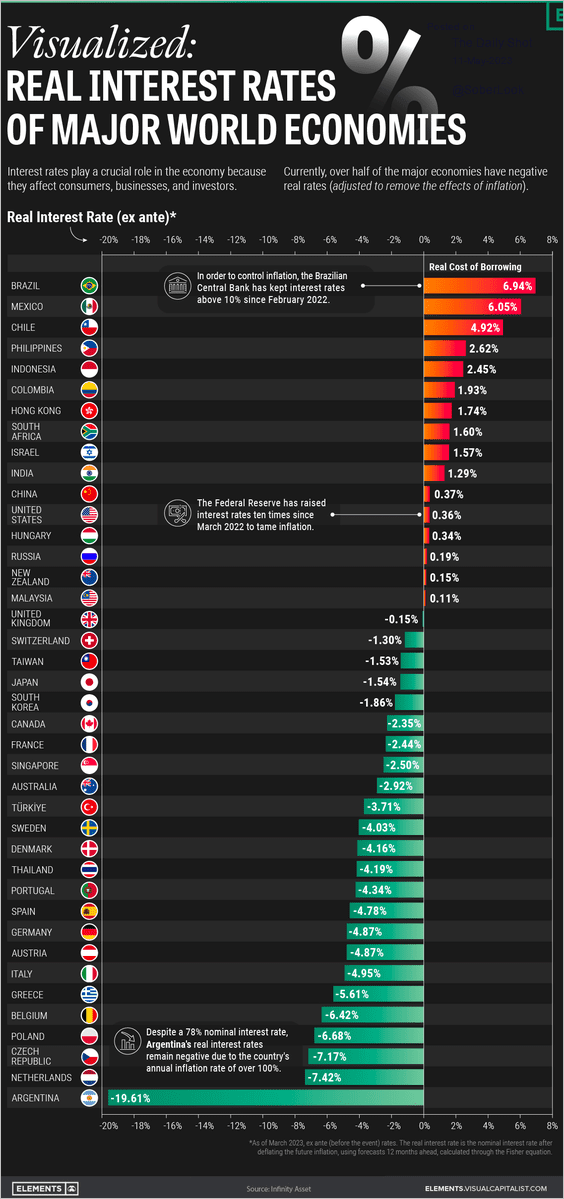 Source: Visual Capitalist Read full article
Source: Visual Capitalist Read full article
——————–
Food for Thought
1. Bloomberg’s terminal vs. non-terminal revenues:
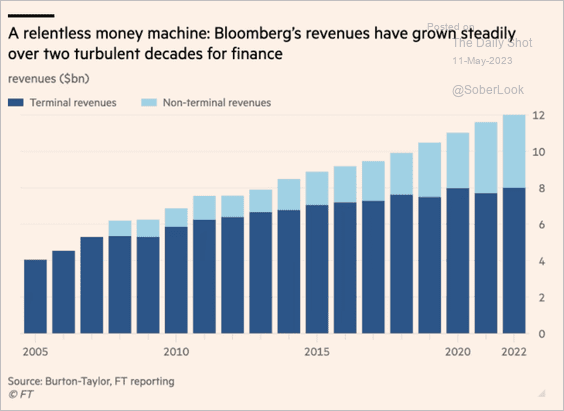 Source: @financialtimes Read full article
Source: @financialtimes Read full article
2. Anti-ESG shareholder proposals:
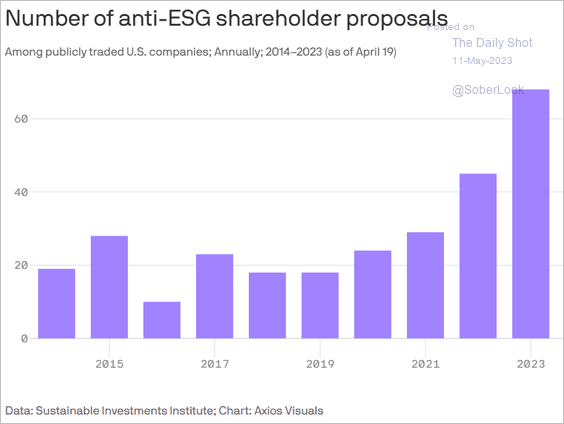 Source: @axios Read full article
Source: @axios Read full article
3. Vice valuation over time:
 Source: @chartrdaily Further reading
Source: @chartrdaily Further reading
4. Cutting back on parking spaces:
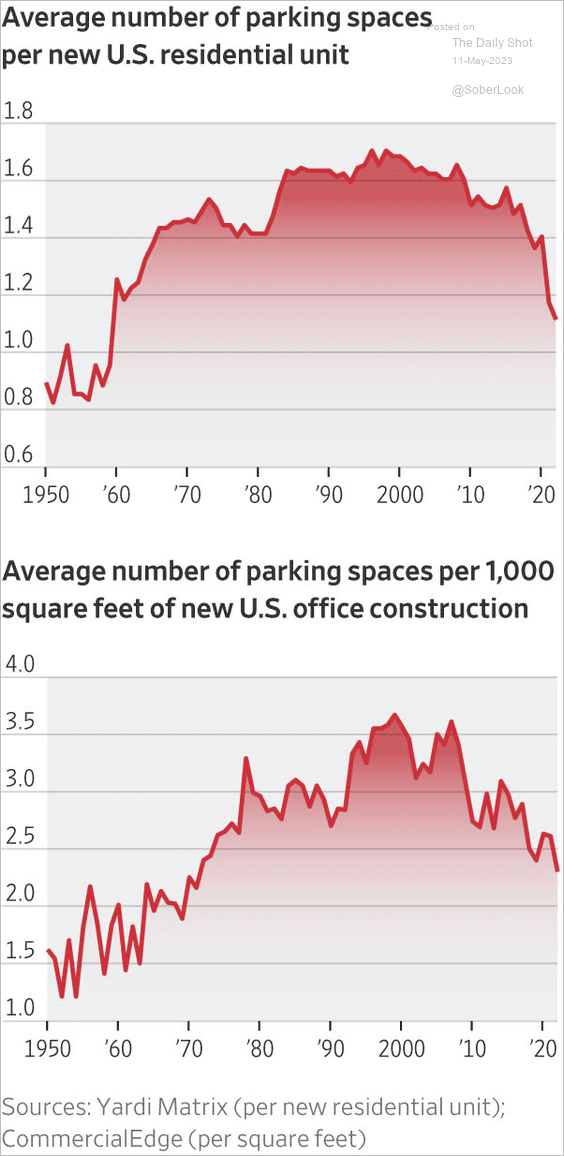 Source: @WSJ Read full article
Source: @WSJ Read full article
5. When did each state become “majority truck”?
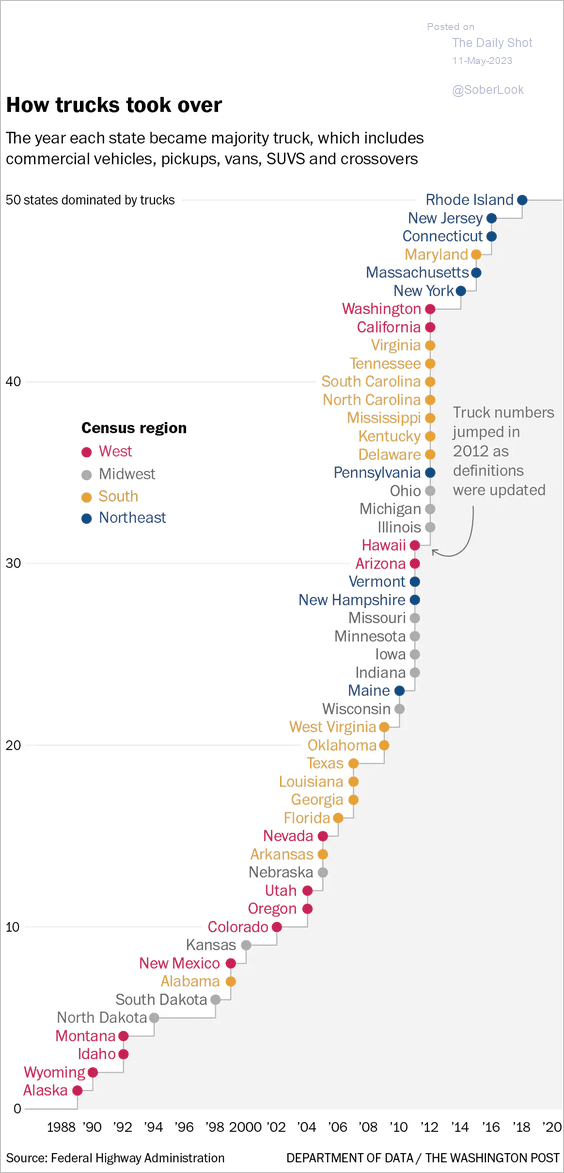 Source: The Washington Post Read full article
Source: The Washington Post Read full article
• Truck share by state:
 Source: The Washington Post Read full article
Source: The Washington Post Read full article
• Vehicle production by type:
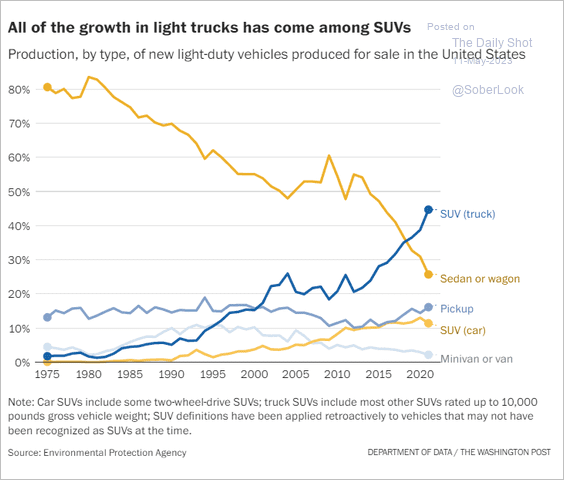 Source: The Washington Post Read full article
Source: The Washington Post Read full article
——————–
6. Hawaii tourism:
 Source: @chartrdaily
Source: @chartrdaily
7. Hate crime incidents on the rise (2 charts):
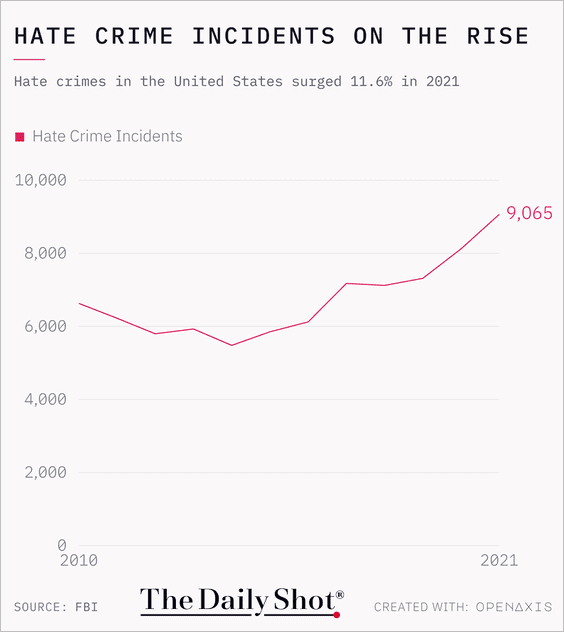 Source: @TheDailyShot
Source: @TheDailyShot
 Source: Statista
Source: Statista
——————–
8. How long do college seniors expect to stay at their first job?
 Source: Quality Logo Products
Source: Quality Logo Products
9. The most expensive dog breeds:
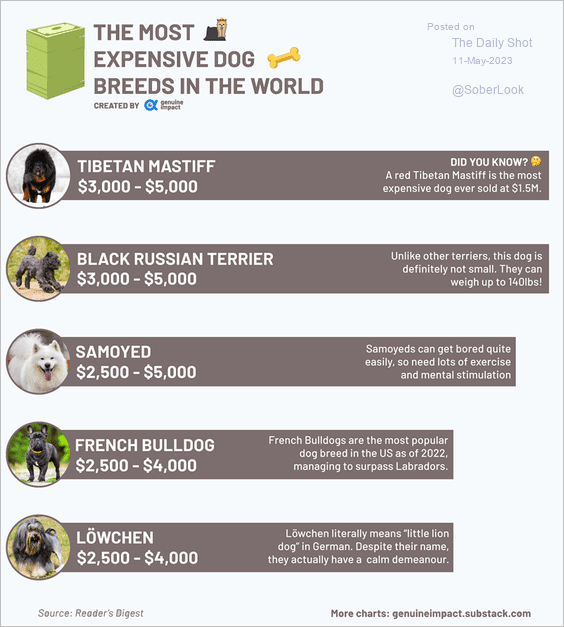 Source: Genuine Impact
Source: Genuine Impact
——————–
Back to Index
